






















Thanks for joining us! We are a free, premier livestock publication featuring and serving seedstock and commercial beef producers nationwide. Raising cattle is so much more than a hobby; it is our livelihood and our passion. We understand that, and in every issue want you to see not only incredible cattle, but also relatable, entertaining, and informative editorial features for the producer with 5 or 500 head.
To us, you are more than reader or advertiser; you are a beef producer. We are committed to doing our best for you, every day. Please feel free to communicate with us, your input is appreciated.
641.425.2641
Bill and his wife, Nancy, have made their living in the cattle industry. He has provided marketing services for purebred and commercial breeders since 1970. Schermer Angus Cattle continues to be active in the NJAA and raises quality cattle near Clarion, IA. As owner of The Stockman, Bill leads by example providing producers with the highest level of customer service.

CHERYL KEPES, Assistant Editor

417.766.0990
cheryl@stockmanmag.com

Working for The Stockman is the perfect combination of two of Cheryl’s favorite things: writing and cattle. Cheryl has decades of experience as a professional writer. She finds great joy in sharing stories about people in the agricultural industry. Cheryl’s family raises registered Angus, Red Angus, and Simmental cattle in Fair Grove, MO.
Cheryl Kepes
Sarah Hill

Justin Fruechte
Dr. Vince Collison
Kirk Lynch
KIM BANKS, Graphics
507.530.0914

kkbanks@frontiernet.net
Makayla serves as editor, graphic designer, and manager of The Stockman. Her focus and passion continues to provide high quality service and original promotional materials to cattlemen. She and her husband, Jared, raise their four kids, and together they run their family operation, JMF Herefords and SimAngus, near Morris in west central MN.

Kim is a graphic designer with many years of design experience. Producing creative marketing materials to help others look their best is what she loves doing the most. She and her husband, Kevin, along with their son, raise grain and have a small commercial cow/calf and feeder operation on the family farm near Lynd, MN.
SARAH HILL, Editorial Writer
307.274.0419
sarahhill1007@yahoo.com
Sarah lives on a small hobby farm near Arlington, SD, with her husband, Braeton, and their three daughters: Harper, 8, Vayentha, 5, and Aurora, 1. She grew up on a Missouri dairy farm and has an Agricultural Journalism degree from the University of Missouri. Sarah enjoys baking, reading, and gardening.
TY BAYER
715.573.0153
tcreds@gmail.com
Ty works alongside his family in their purebred operations, Country Lane Farm and TC Reds near Ringle, WI. An advocate for youth programs and dedicated cow/calf man, he is excited to help producers merchandise their cattle.
MILES EDDY
507.841.1787
auctioneer2013@gmail.com
Miles grew up in southwest MN raising and showing cattle, and is currently residing in MO. When Miles isn’t working cattle he loves to use his auctioneer skills. He looks forward to working and meeting other producers and helping with all their advertising and marketing needs.
RON HINRICHSEN
785.770.0222
rlangus@bluevalley.net
For the past 30 years, Ron, his wife, Lynne, and their two children have owned and operated Hinrichsen Ranch, a registered Angus ranch in Westmoreland, KS. He has an extensive background in the agricultural industry and is excited to put it to work for each of his customers.
MARK SULLIVAN
816.304.0050
marksullivancattle@gmail.com
Mark Sullivan is a familiar face to many having worked for Sullivan Supply for many years. Mark brings many years of experience to The Stockman. Mark and his wife, Linda, and two children, Erin and Leo, live in Woodbine, Iowa, and have a small herd of Charolais cattle.
CORBIN COWLES
270.991.2534
corbin.cowles32@gmail.com
Corbin is an apprentice auctioneer and real estate professional for Schrader Real Estate and Auction company. He also helps run his family’s Angus and Simmental seedstock operation, Pleasant Hill Farms. Judging shows across the country and traveling are a couple hobbies of his as well!





JAN FORD
800.693.8048
jford.17879@aol.com
With her passion for agriculture, Jan brings over 35+ years of advertising sales experience in the beef industry. She and her late husband Norm had a commercial Angus cow herd and grain operation near Tipton, IA, which her sons still manage today.

LORA HUTCHINS

615.293.3695
loralea1172@gmail.com
Lora owns and operates Destiny Angus Farm with husband Brian and daughter Morgan in Charleston, IL. They have raised and shown cattle successfully on the national level for several years. They also have owned a production herd with as many as 200 registered cows.

BRANDON CREAMER
970.596.4965
creamer b 150@hotmail.com
Brandon owns Lazy JB Angus with his parents and sister in Montrose, CO. Raised in the cattle industry, he has a true passion for it and loves marketing quality cattle throughout the US.

ZAC HALL 701.595.6887
zac@fortelivestock.com
Zac is active in his family’s operation, Hall Stock Farm, near Berthold, ND raising registered Angus, Sim-Angus and commercial cattle. He loves working with livestock and youth and as a Livestock Judging Coach.

BRIGHAM STEWART / MEGAN COLLISON
785.747.8028
megancollisondvm@gmail.com
Brigham works alongside his parents at Mid Continent Farms, their large, multi-breed cow/calf operation in Kansas. Megan graduated from ISU as a DVM in the spring of 2021 and is a big part of her family’s Angus herd and Veterinary Clinic in Iowa.
Open Box Rafter Ranch leverages its rich history in American Quarter Horses and Angus cattle to great success today.


A new evaluation program aims to identify genetically superior animals.
Sunrise Sunset Farm aims to produce champions in the show ring and in life.

Sales, shows, and national steer awards. Part 2 of a multi-part series.
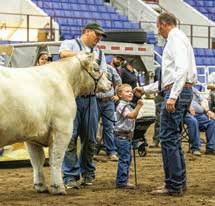


with Justin Fruechte of Millborn Seeds
with Dr. Vince Collison, Collison Veterinary Services
Q&A with Dan Fawcett of Ree Heights,
Hello, hello!

What a wild and fun few months it has been! My family of six has been home together all summer, and just when I feel like we’re getting in a good swing of things, it will be time for them to head back to school. In our time together this summer, we’ve laughed and cried and everything in between, and although we have had some difficult moments, I wouldn’t trade this time with them for anything. It’s been a whole new dynamic lately with the kids being old enough to go out and do things like gather or sort cows on their own. It wasn’t too long ago we were stocking up on diapers and feeding bottles around the clock. Now the kids are talking about buying pickup trucks and living in houses of their own some day. Oh, how seasons (quickly) change!
In a flash the days of summer will be behind us and the fall sale season will be upon us. Keep The Stockman in mind when you are planning your fall sale. We can assist you in catalog design and any promotion materials that you may need. We’ll take you from start to finish - planning, printing and all. Contact me for a free, no-obligation quote at any time.
Have a great rest of your summer - we’ll be diving head first into the fall season soon enough!
half page $450
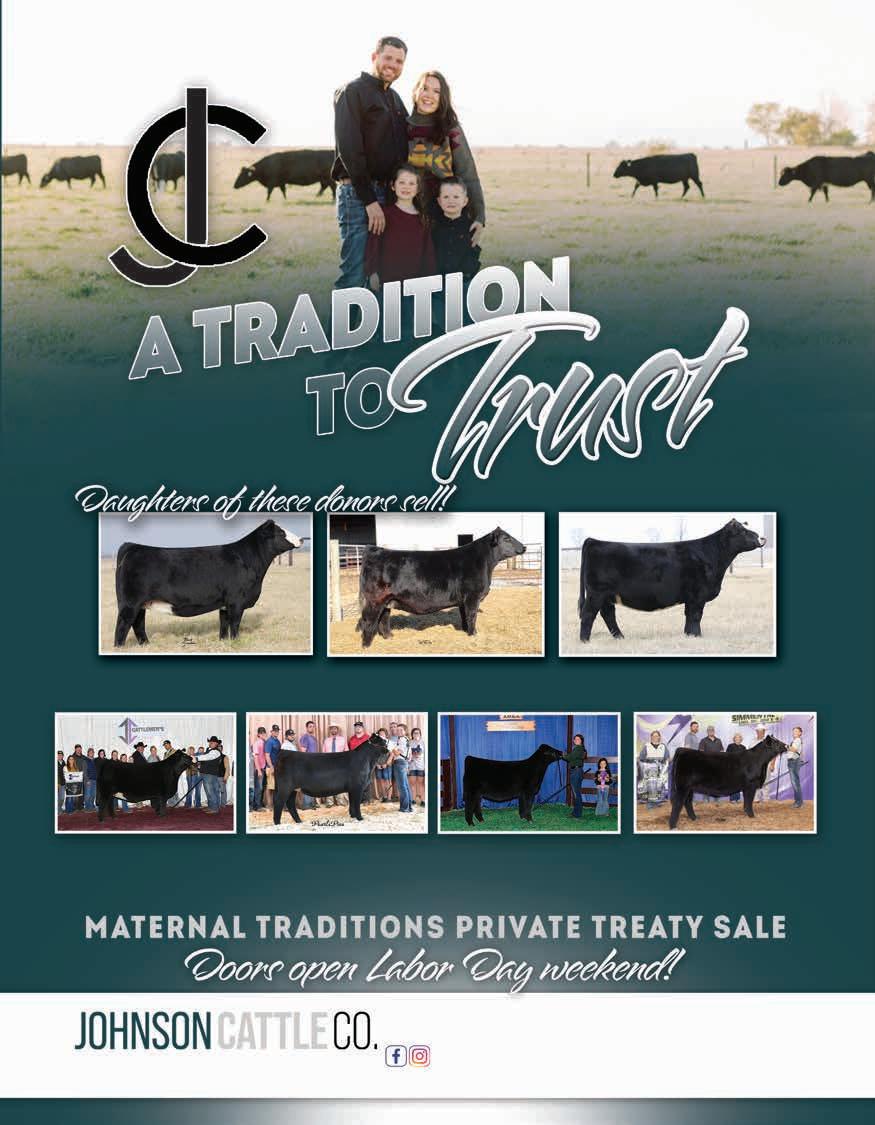

SHORTHORN SHOW HEIFER OF THE YEAR

ANGUS SHOW HEIFER OF THE YEAR


SHORTHORN PLUS SHOW HEIFER OF THE YEAR






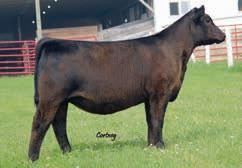




and Angus cattle to great success today.
family with a strong faith in God, American Quarter Horses, and Angus cattle calls Open Box Rafter Ranch home, near Faith, S.D. Jim Hunt and his wife, Joni, are fifth-generation ranchers who operate the Open Box Rafter Ranch.

Jim’s heritage is Lakota, and he’s a member of the Cheyenne River Sioux tribe. His family has been ranching on the Cheyenne reservation for more than 100 years. One of Jim’s grandfathers, Alberto Francisco Lopez, was of Spanish descent and came to South Dakota in 1923 as a wagon boss for Diamond A Cattle Company. Lopez leased land on the reservation and stayed, developing a Quarter horse breeding program. He hosted his first annual production sale in 1943.
“Grandpa Lopez raised Coffee Jeff, and Paul Tierney purchased him. Paul Tierney went on to ride Coffee Jeff when he won the World Championship in calf roping in 1979 and the World all-around championship in 1980,” Jim said.
By Sarah Hill photos courtesy Jim and Joni HuntJoni also hails from a ranching family near Belvidere, S.D., and has political ties in her family tree. Her great-grandfather, Tom Berry, was governor of South Dakota from 1933 to 1937. “Our grandparents both became members of the American Quarter Horse Association (AQHA) in 1949 and were some of the first AQHA members with registered horses in South Dakota,” Jim said. “There are only a handful of families in our state with that early history for the American Quarter Horse, and both Joni and I are proud to be part of that group.”

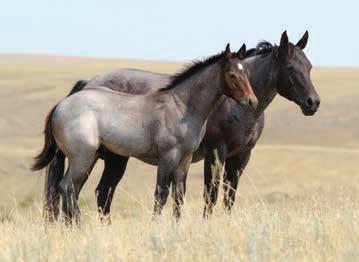

Jim was involved in 4-H as a youth and attended a private Christian high school before attending South Dakota State University on a rodeo scholarship. Jim had success riding saddle broncs in college, and even competed for several years on the PRCA circuit. Although Jim never made it to the national finals,
he won the Great Plains College Region in Saddle Bronc in 1981 and 1982 and was a runner-up in 1983; won the title in saddle bronc at the NRCA world finals in 1982; qualified for the college national finals in saddle bronc; and the Badlands circuit finals in 1984. He also did team roping, steer wrestling, and rode bareback.

Meanwhile, Joni graduated from the University of Virginia with a nursing degree. The pair connected in Wyoming while Jim was working at a bank, and the pair tied the knot in 1987. Not long after, the Hunts bought a ranch not far from where Jim grew up and started their own horse breeding program and raising their family.

Jim and Joni are the proud parents of seven children:

• J. Tom and his wife, Sage, work on the ranch and have five kids, Elizabeth and Rebeca, 5, Hannah and Jack, 3, and Elloise, 9 months.
• Jessica currently manages Open Box Rafter Ranch’s horse program, with a little time for her massage therapy business.
• Justin, a flight instructor, is currently at training for helicopter maintenance in the South Dakota National Guard; he and his wife, Erica, a teacher in Rapid City, are expecting their first child in October.
• Josh just finished two years as Dean of Men at an Oregon Bible college and is overseeing the haying operation on the ranch this summer.
• Jordan serves in the Army National Guard and is finishing a business degree; he and his wife, Grace, a graduate of the Oregon State University veterinary medicine program, live in Weatherford, Texas.
• Jeb is a professional certified journeyman farrier near Brock,
Texas; he returns home for the horse sale, shipping calves, and spring branding.
• Jimmie Jean is getting foals ready for the September horse sale; she plans to work towards a nursing degree.
Jim proudly shares that Jordan won the high school state saddle bronc title in high school, and all the Hunt kids have participated in high school rodeo; mainly roping, cutting, steer wrestling, and working cow horse events.

“A good horse has always been a useful friend and tool on the ranch,” Jim said. “Our family heritage has been good genetics in horses, so we were really serious about genetics when we went on our own.”
The first thing the Hunts did was purchase Sonny Sugar, a son of Sugar Bars. Jim said that the Sugar Bars line has one of the most dependable and predictable genetic lines in the AQHA. Sonny Sugar was 21 years old when the Hunts bought him, and they got four crops of foals out of him.






“Crosses with horses from the Sugar Bars line have produced many horses that were successful as cutting horses to roping to barrel racing,” Jim said. “We tried to build the nucleus of our breeding program around those same bloodlines.”
The Hunt family breeds 100 broodmares each year and sells both stallions and mares. They focus on breeding for sound legs, conformation, and athletic ability for stallions. For mares, they emphasize strength and balance. “Seventy-five percent of a colt’s traits come from the mare,” Jim said. “Good horses, like good men, have good mothers.”
While the Hunt family likes predictable genetics, they’re also not afraid to try to promote newer, up-andcoming stallions. “We currently have sons out of Frenchmans Guy, Dr Nick Bar, Sun Frost, Sonny Pep San, Special Effort, Dash Ta Fame, and Fire Water Flit,” Jim said. The Hunt family started hosting their own annual production sale in 1994, after years of selling their horses through an extended family production sale, and they also sell horses through private treaty.
In 2012, Jim was honored to be asked to become a national director for the AQHA. Eight years later, he began serving on the executive committee, and will become president in 2024. In addition, Jim serves as a deacon for the family’s church.
“It’s very rewarding to serve an industry that’s been such a rich part of our lives,” Jim shared. “I’m delighted to be part of the AQHA and help recognize the ranching and livestock industries. So many people are dependent on a good horse in ranching, rodeos, horse shows, county fairs, and with youth.”
The Hunts are particularly proud of their involvement in developing a program through the AQHA called the Young Horse Development program in 2012. “Each year, we donate 5 to 6 registered foals to the AQHA, and the youth department selects young people to receive those foals,” Jim explained. “Other ranchers have joined us, and now the AQHA places 45 to 50 foals per year. It’s a winwin because our colts get into the hands of these very excited youth. The kids bond with the colts and learn responsibility as they care for the colts and train them—they



learn so many valuable life lessons. The result has created some topnotch young adult leaders.”
Jim said it’s his belief that kids who are engaged with livestock are healthier minded, have more focus, objectives and purpose.

In addition to the thriving Quarter Horse operation, the Open Box Rafter Ranch has a black Angus commercial cow operation with 400 to 500 head. Cattle graze on native grasses, although the Hunt family does have a few alfalfa fields for hay. Cottonseed cake makes up the rest of the herd’s diet through the winter, in addition to grazing. “When the snow gets deep, we do have some stockpiled hay, so we can supplement with that when needed,” Jim said.
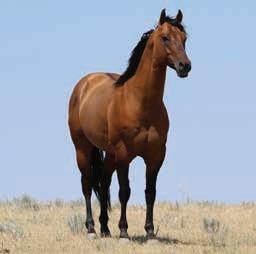



While the Hunt family primarily uses bulls for breeding their herd, some artificial insemination is used on replacement females. “We calve our herd outside, but not until April, when we’re at less risk of having bad weather,” Jim said. “We breed for calving traits and moderate birthweights. Because pounds pay the bills, we select bulls that breed for maternal traits with high EPDs in milk. We also like moderate size cows.”
LOOKING FORWARD
learn
THE STOCKMAN | August 2023 17

Reckoning is becoming the outcross pedigree sensation among breeders looking to improve “show-ring” presence, foot & structure quality, muscle mass, and body dimension!
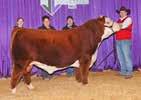
Optics is becoming an extremely popular heifer bull who’s leading progeny are topping Hoover’s, Panther Creek, & RAML’s herds! Added frame and performance for a heifer bull with outcross pedigree to most popular sires! Make sure you research him.








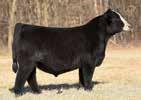










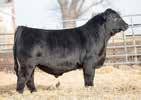












Put a big dent in resistant fly populations with a fall application of BRUTE® .
Studies show that the best way to stop resistant flies from attacking your cattle next spring is to hit them with an application of BRUTE® Pour-on for Cattle this fall. BRUTE® controls horn flies, face flies and other biting flies, as well as Gulf Coast ticks and lice.

So make sure resistant flies don’t come back to haunt your herd next spring by treating your cattle with BRUTE® this fall.
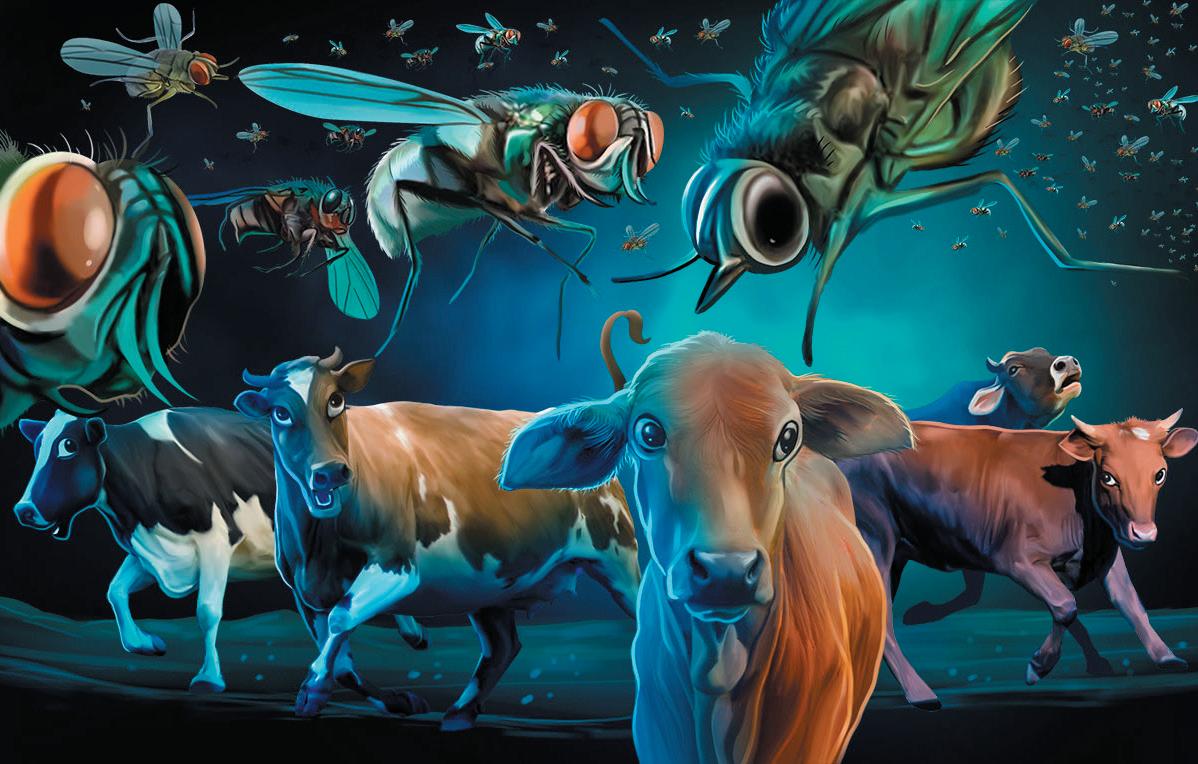
Don’t let resistant flies come back to haunt your cattle next spring.
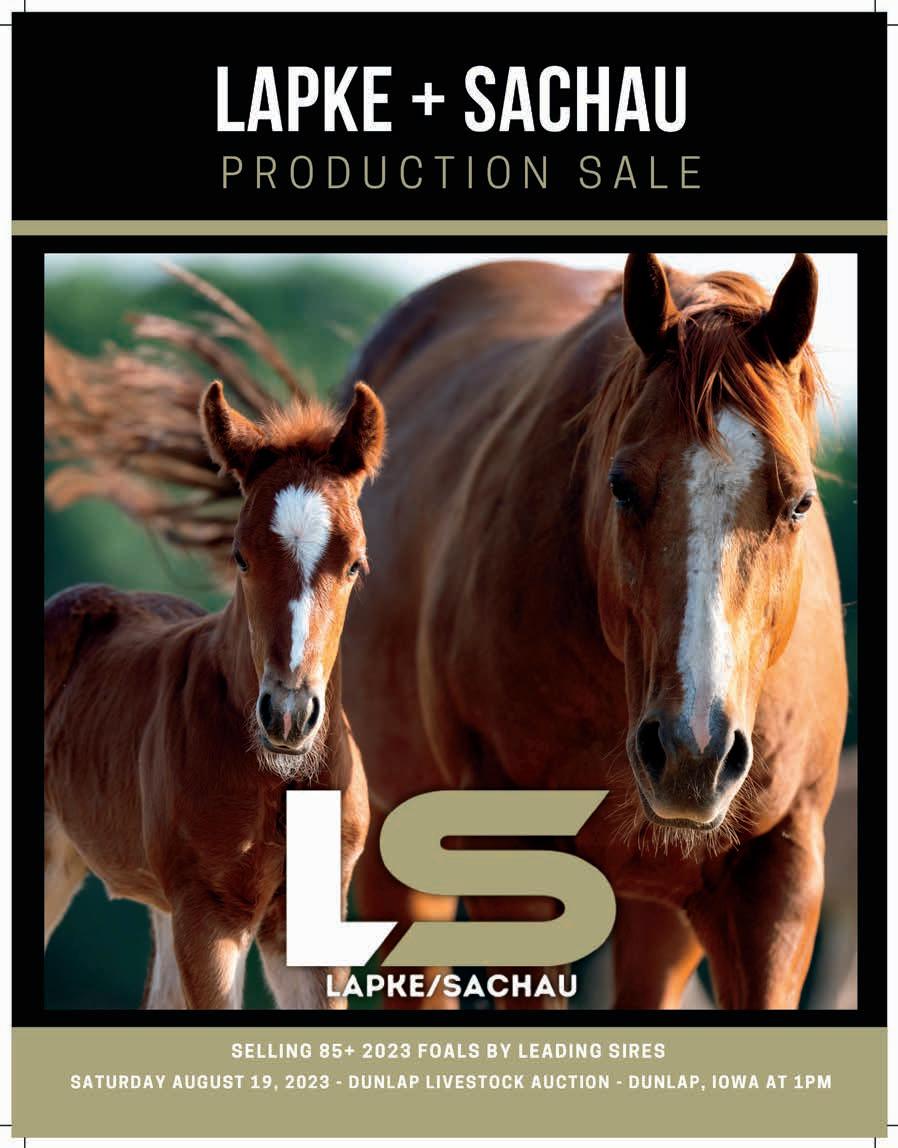
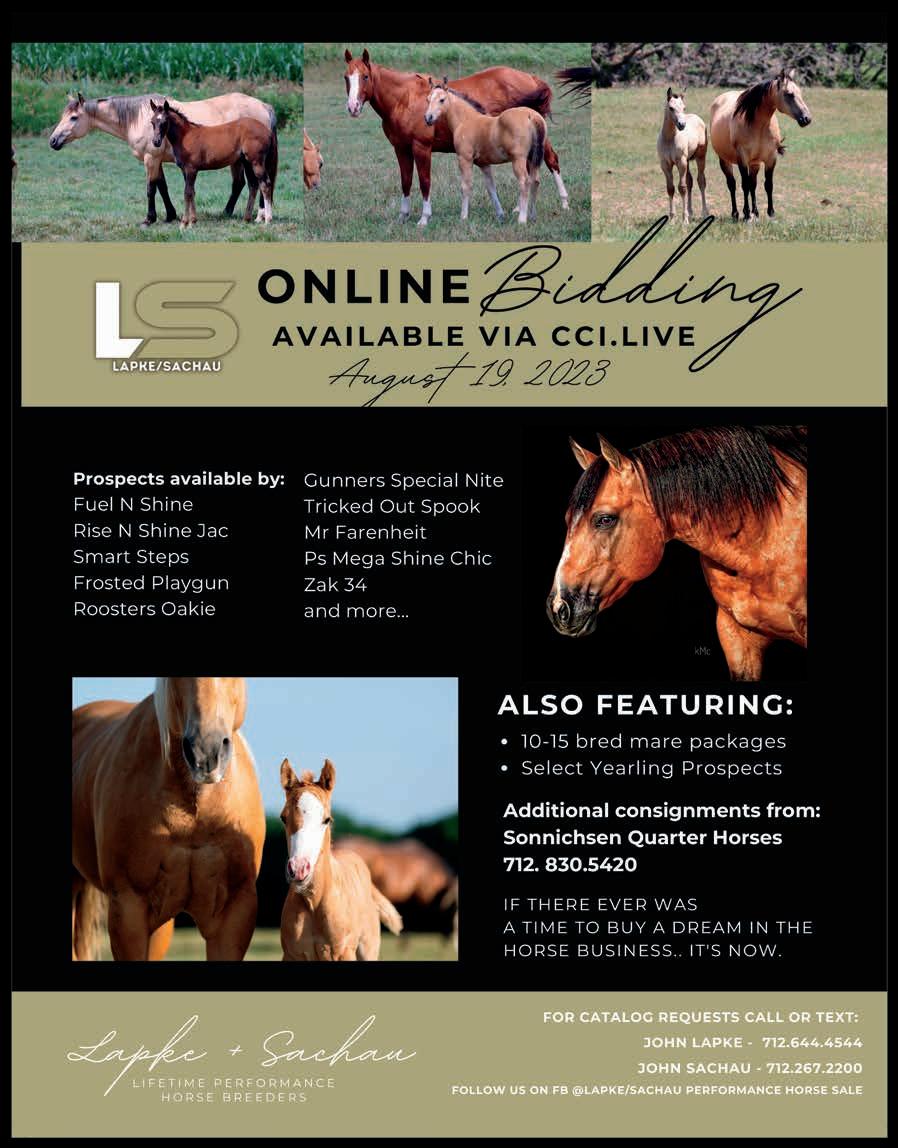 Halden Clark, DVM MS, Health Stewardship; Great Plains Veterinary Educational Center Aaron Berger, Nebraska Extension Beef Educator University of NE - Lincoln, UNL Beef beef.unl.edu
Halden Clark, DVM MS, Health Stewardship; Great Plains Veterinary Educational Center Aaron Berger, Nebraska Extension Beef Educator University of NE - Lincoln, UNL Beef beef.unl.edu


Though the stress of calving season is behind us, cattle producers have to stay vigilant, because things like nursing calf pneumonia and pinkeye can take a lot of the fun out of baseball games and county fairs. Let’s take a quick look at summer/ nursing-calf pneumonia.
Beef producers normally spot this condition when they notice a listless calf with droopy ears and a high body temperature (fever). The calf may or may not cough or have
visible difficulty breathing. Speak with your veterinarian if you have questions regarding how to best approach vaccinating calves as well as what you’ll want to use to treat summer pneumonia if you identify it in your calves. Treatment is usually effective with this condition when administered early in the course of the disease.
Cattle in some parts of the country endured prolonged weather stress this past winter, and many cows ap -
pear to be thinner than usual, even in areas not affected by the historic and devastating winter weather. Due to the winter stress on cows we suspect a large percentage of calves received lower quality colostrum than usual this year, which may make them more likely to get sick, including with summer pneumonia. We’ve heard about lots of struggles with calf health across the state this spring, which means it will be especially important to keep very close tabs on calf health this summer, and if treatment is necessary, to intervene earlier rather than later.
If the calf dies, a veterinarian can generally diagnose this condition with a high level of certainty during a post-mortem exam. Having these calves posted by a veterinarian can also rule out other possibilities and allow the vet to recommend the ideal course of action for future cases. During the summer months it is very important to get any dead calf that will be presented for a post-mortem exam to the veterinarian as soon as possible, because the carcass will decompose rapidly in hot conditions, which may make
it impossible for a vet to accurately diagnose.
A recent survey of veterinarians led by AR Woolums suggested that across the Plains states about one in five herds will have cases of summer pneumonia in a given year. In a related survey of beef producers by the same research group, the number of cases of summer pneumonia appeared to correlate with herds that had fought scours in the calves, had a calving season that lasted three months or longer, or that brought in orphan calves from other farms.

Dr. Richard Randle wrote a BeefWatch article, Summer Pneumonia in Beef Calves, in July of 2015. In it, he explained a case-control study in Nebraska, South Dakota and North Dakota beef herds to better identify risk factors for nursing calf pneumonia. The project was completed, and identified several risk factors for the condition, including increasing herd size, especially herds with 500 cows or more, intensive grazing, and estrus (heat) synchronization. It is thought that these practices increase the number of “effective contacts” between calves, meaning they have more chances to effective-
ly spread bacteria and viruses to one another. These practices may carry significant benefits for the beef operation, but care must be taken to manage the associated risks.
Courtesy University of NE - Lincoln, UNL Beef
Interviews with the authors of BeefWatch newsletter articles become available throughout the month of publication and are accessible at: www.go.unl.edu/podcast.

 by John McDonald
by John McDonald
• Pull on highway at speed limit.
• Fits through any gate your pickup will.




• Stable on uneven terrain.
• Permanent sheeted adjustable alley.
• Transport wheels are permanent, no sliding off the axles and rolling out of the way.
• Wheels on each panel and electric over hydraulic jack eliminates lifting— saves time.

• Frame gates for sorting.
3 Sizes Available!






Cattle producers utilize all sorts of tools to predict whether an animal will succeed or fail in their herd. Whether its reliance on EPDs, phenotypical appraisal, an animal’s past production record, or any combination of factors, livestock producers continually strive to produce healthy, efficient calves that are better than the generation before.
In the last few years, a new evaluation tool has emerged on the beef industry scene and its quickly gaining the attention of beef cattle producers. The scientists responsible for the discovery and application of the new evaluation program say it can help take some of the guesswork out of whether an animal will thrive in a herd.

The science and technology used to develop the evaluation program, named Promogen™, stems from years of work and research conducted by scientists at Anova Biosciences, located in Omaha, Neb. Twenty years ago, researchers at the University of Nebraska discovered the biomarkers which are now at the heart of the Promogen™ program. The initial research revealed a protein in the colostrum of dairy cattle that was thought to aid in the prevention of mastitis and pass immunological protection to calves.

In 2004, researchers at the University of Nebraska and Anova Biosciences received a grant from the Bill and Melinda Gates Foundation to work together to determine what role the newly discovered protein played in natural immunity. During their research they learned there were three proteins, not just one. Over the course of three years the collaborators developed the tools necessary to measure the presence and concentration of the proteins. This was the springboard for decades of research and new scientific findings.

Under the direction of Dr. William Julien, a scientist, veterinarian, and CEO of Anova Biosciences, the research ramped up with the newly discovered proteins. In the years to follow, researchers would gain more knowledge about the three proteins that they eventually named Defensins. “Defensin proteins are biomarkers for things that have to do with energy in the cell,” Dr. William Julien explained.
According to Dr. Julien, research indicates an animal’s Defensin levels are strong predictors of its ability to deal with stress, while stress resistance positively impacts everything from disease resistance to feed efficiency to productive longevity. The Defensins are measured through the Promogen™ evaluation program. The Defensin levels can be analyzed through a Promogen™ test conducted on samples of raw or frozen semen, saliva, uterine mucus, and freshly harvested colostrum. The animal’s Promogen™ score is a measurement of the concentration of the Defensins in an animal.


Dr. Julien and his team have tested hundreds of pigs, thousands of dairy and beef cows and bulls, as well as non-domesticated animals such as whitetail bucks, buffalo, and wild ox. “By now we have tested over 4,000 cows of all breeds between here and in Europe. The results reported from these tests are consistent as is the accuracy of the performance predictions made from the results of those tests,” Dr. Julien said. According to Dr. Julien, the animals topping the Promogen™ scale are more likely to exhibit traits that set them up to be sustainable in a herd.
One of the earliest experiments conducted by Dr. Julien and his team involved collecting samples from the colostrum of 375 dairy cows. “To make a long story short, we found that about one-third of the population tested, regardless of breed, didn’t produce these proteins
in physiologically effective levels. These cows we called bologna cows. The thing that was not expected was that we found an additional one-third that produced these proteins at five to seven times normal. These cows were referred to as super cows,” Dr. Julien explained.



The researchers then followed the dairy cows for 180 days documenting productivity and incidences of
mastitis. Their findings revealed the cows with the higher concentration of the proteins (Defensins), had significantly reduced incidences of treatable mastitis. Additionally, the cows with high levels of Defensins produced more milk compared to the other cows in the experiment. “What we found when we looked at the parameters (milk production and mastitis incidence) that we used as indicators of pro -
tein activity, the super cows out produced their herd mates by an average of 5,000 pounds, which is a lot,” Dr. Julien stated. “They also had a significantly lower incidence rate of treatable mastitis.”
In addition to the quantifiable findings, researchers say they have observed behavior unique to animals with high Promogen™ scores. These animals picked up the name “super” cows or bulls from Dr. Julien and others familiar with Promogen™. One example of this observed behavior is the way the “super” cows interacted with the other cattle in the herd. “The super cows could move from group to group without any warfare, they had their snouts in the trough all the time, and you could walk into that area and touch them. Nothing phased them,” Dr. Julien explained. Their behavior and ability to adapt to changes in their environment gave the “super” cattle another advantage over their counterparts. “The simple way for me to translate that behavior is that they are more stress resistant,” Dr. Julien said. “They are able to deal with whatever comes at them and they are able to do a better job of it.”
According to Dr. Julien, this behavioral characteristic coupled
with the physiological advantages possessed by high scoring animals, gives them a solid foundation to be more productive, feed efficient, and disease resistant compared to animals with average or low Promogen™ scores.
Defensins are inherent proteins in which activity and concentration are constant from birth. They are highly heritable, but about 75 percent of that heritability is maternal
in origin, although the sire does influence the degree of expression. “This is why cow families are so important,” Dr. Julien said. “My grandpa always told me that the cow paints the picture, while the bull puts the frame on it.”
Advocates of the Promogen™ evaluation program appreciate the ability to collect a sample on a calf, bull, or cow and receive results that are consistent no matter the animal’s age or environment. “We know we can identify these animals at birth. We can pick the winners

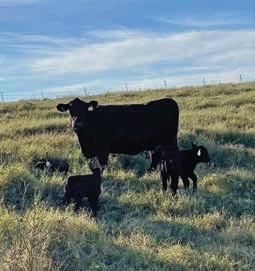
right then. And they stay winners the rest of their life,” Dr. Julien commented.
Dr. Jeff Gower, owner of Soaring Eagle Farms of the Ozarks, started to implement the Promogen™ genetic evaluation program on his Angus herd in 2020. Every animal in Dr. Gower’s herd has been tested to assess their concentration level of Defensins. “The bottom line is in my opinion Promogen™ takes the gamble out of raising these animals,” Dr. Gower said. “I am tight as the come, I don’t gamble. But Promogen™ allows me to spend money that I normally wouldn’t do because breeding animals is strictly a gamble. And I don’t want to wait four years to find out of the animals are any good.”
Some producers use the Promogen™ evaluation program as a tool to determine which animals to cull or keep. In the case of Soaring Eagle Farms of the Ozarks, Dr. Gower relies on an animal’s Promogen™ score to build up his herd and to guide breeding decisions. “You can use this test and you can cull your herd just by using Promogen™,” Dr Jeff Gower said. “I use it the other way – I identify the superior ones.”

Researchers associated with the Promogen™ program who are working alongside cattle producers say their findings indicate cattle scoring high on the Promogen™ evaluation scale also rank at the top of their breed’s EPD charts. “For the high scoring individuals, the likelihood of the EPD traits being fully expressed is much greater than for low scoring individuals. EPD expression is dependent on cellular energy availability, and cellular energy availability is what Promogen™ is measuring,” Dr. Julien stated.
The use of Promogen™ to identify feed efficient cattle is one application that Anova researchers have focused on, and over the past several years, several studies have been conducted to see if there is a correlation between feed efficiency and Promogen™ score. “These have been conducted in several locations across the country and all were done independently. Most of the studies employed GrowSafe equipment or systems that are comparable to measure individual animal performance. Several hundred bulls of all breeds were Promogen™ tested and their scores
- Dr. William Julien
“We know we can identify these animals at birth. We can pick the winners right then. And they stay winners the rest of their life.
then related back to what their performance was in the monitored feeding trials. Once again, it was a linear relationship, just like in the dairy cows; the higher the Promogen™ score, the more feed efficient they were,” Dr. Julien stated.
Additionally, Dr. Gower states when he transitioned his herd to average to high scoring Promogen™ animals, he witnessed an overall healthier herd and subsequently a decrease in veterinarian bills. “With a focus on high scoring Promogen™ genetics my vet bills went down 42 percent,” Dr. Gower said.

Every day brings a new discovery and further understanding of these proteins. “There is a WOW moment every day,” Dr. Julien expressed with a smile. The research reaches far past the cattle industry. Anova Biosciences is working on several different research projects that involve these proteins in humans. “What you have to realize is we are breaking ground here. What we know about these proteins there is no prior literature, there is no peer review literature, there is no one you can go to talk about this. Because this is not genomics, this is not built on an algorithm, it is not a guess. It is something that is inherent in you, you are born this way,” Dr. Julien said.
Currently, the thoracic surgical group at Massachusetts General has an ongoing study on post-surgical recovery rates and have included the Promogen™ program as part of their research protocol.
Additionally, Anova Biosciences is working with another group at the University of Nebraska Medical Center on the development of an analytical method to detect distinct expressions of mitochondrial disfunction as to relates to specific diseases.
The new findings and data keep Dr. Julien and his researchers moving forward with excitement and anticipation of what they will uncover next, whether it’s an application to help livestock producers or humans. “I don’t think Promogen™ is like magic, it is a physiological measurement that has an impact on everything else’s expression. It’s not a suit of armor but the benefits are there,” Dr. Julien said. And that coupled with what he has learned so far is enough to keep he and his team devoted to uncovering the Defensins full potential.
learn more anovabiosciences.com promo-gen.com


Our proven genetic test unlocks the information you need to identify top-performing, stress-resistant “super cows” on your ranch — and select for more profitable, sustainable herds. Promogen measures the levels of Defensins, proteins that impact an animal’s ability to respond to stress and disease, and predicts performance.
Promogen testing on more than 4,000 head proves high-scoring, “super” cattle are:


•more disease resistant;
•less likely to require veterinary intervention;
•more responsive to vaccines and less likely to require antibiotics;

•more likely to conceive and carry a calf to term;

•more likely to wean a healthy calf; and are
•better able to handle stress and are easier to work.
High-scoring cattle also:
•consume less feed;
•drink less water;
•grow faster;
•produce less methane;
•produce beef that’s more tender; and are
•more profitable.
Data collected on 150 head of commercial Angus bulls, heifers and steers show profitability is driven by sustainability. from added growth and performance through finishing.


To start testing for a more sustainable herd, visit promo-gen.com Dr.

1. The system uses a numerical score of 1 to 6.
2. Animals with scores of less than 4 are not producing the three marker proteins we are measuring at physiologically effective levels.
3. Animals scoring between 4 to 4.5 are producing the three marker proteins at levels that are physiologically average

4. Animals scoring between 4.5 to 5 are in the top 25% of the populations we have tested. This includes both beef and dairy cattle.
5. Animals scoring over 5 are in the top 5%.
6. Animals scoring 6 are in the top 1%. We believe that these individuals are extraordinary.
Immunologically superior animals are proven to return higher significant gains across all traits: overall wellness, fertility, and feed efficiency.
Profits on overall wellness are realized through in increased response to vaccines and antiparasitic treatments, drastically reducing the incidence of morbidity and antibiotic use.
Fertility is reflected in higher conception rates, reduced risk in early embryonic death, weaning calves at higher weight ratios, and overall retention and longevity in replacement females.
Feed efficiency is directly affected by the body’s ability to ward off inflammation due to environmental stress factors.
Cattle on feed who possess this natural ability have higher conversion rates than their counterparts who are immunologically inferior – all without commanding additional medicine costs and higher overall expenses.
Immunologically superior animals who possess specific Defensen predictive biomarkers are proven to be more profitable, and aide in economic gains through these highly heritable traits for generations to follow.
Choose immunologically superior animals through Promogen Genetic Evaluation. Choose genetic gold.


By These Ranch

Cookin Merada
Wimpys Hi Roller
Sweet Gallo Oak
CD Cut The Lights
Just A Silver Duck
Rios Santana
A San Peppy Legend
Royal Vaca Rey
Jack Frost Edition
RWS Vacas Benito Bar
Legendary Cutter
Peppy San Holliday
RWS Benito Edition
Doseys Star





Functional forage and pasture.

Do you know the history of the acres you’re farming? What was planted there 100 years ago or 50 years ago? The last few years? What crops have been grown in the soil you’re managing today?
Crop rotations date back to ancient times because those working the land knew that rotating crops helped control pests and diseases and improved the fertility of their soil. In ancient Rome, they used a two-field system, where they plant-
ed half of their land with a cereal crop and the other half was left fallow (and then planted with a legume crop the next year). In the Middle Ages in Europe, the threefield system was introduced, where they planted a third of their acres to a cereal crop, a third was left fallow, and the other third was planted to a legume crop. In the 18th and 19th centuries, the four-field system was introduced, where the fourth field was used for root crops (like pota-
toes or beets), which allowed for continuous cropping.
So how did we get away from these multicrop systems? In the 1950s, Iowa was the top oat producing state in the U.S., harvesting more than 6 million acres of oats to feed to livestock on diverse family farms. Now, as livestock operations have concentrated and farms have consolidated, the need for oats as feed decreased and the law of supply and demand saw oat production decrease to only 73,000 acres harvested in Iowa in 2020 – a 98.8 percent decrease.
But even if livestock feed needs are not creating the same demand for crop diversity, the demand still exists. Think about the demands from:
- soil for diverse nutrient profiles and increased organic matter.
- cash crops for nitrogen fixation.
- the environment for reduced erosion.
- cash flow for decreased chemical and fertilizer application.
The demand is there, it’s just showing up differently.
contributed article by Justin Fruechte, Product Expert - Ag Millborn Seeds, Brookings, S.D. millbornseeds.comRenew your thinking. Revive your land. Repeat your success. As land use linchpins, we’re here to help ensure the continued productivity of your land for generations to come.
In late June of 2023, during the peak of a dry stretch, the U.S. saw the worst crop conditions for that time of year since 1988. It makes you think: what if we focused on creating crop systems that allow our soil to hold water better? What if we had resilient, drought-friendly feed options? What if we shifted our focus to creating crop systems that can handle extreme weather changes? Reviving the soil with a multi-crop approach has more benefits than soil health – it’s an insurance policy against the unknowns of Mother Nature.
And even better yet, research has shown that diverse farms increase their profits by spending less on fertilizer, fuel, and herbicides in the year after they plant small grains. Profitable systems are worth repeating.



It’s hard to fathom, but perhaps our culture of monoculture needs a renewed way of thinking. Perhaps what we consider “normal” needs to be revived. We need to rethink our systems, while still maintaining simplicity and profitability.
No single system will work for every farm, but a simple solution to renew your land exists. Maybe it’s adding a legume for nitrogen fixation. Or adding a brassica to break up soil compaction. Or planting a cereal crop to reduce erosion. Start small – you don’t have to change your whole farm overnight.
The team of folks at Millborn Seeds have roots that run deep in farming, agriculture, and in the overall respect for the landscape. They opened their doors in 1987 and continue to walk alongside farmers, ranchers, and landowners across thousands of acres throughout the Midwest.
 Photos courtesy Millborn Seeds learn more millbornseeds.com
Millborn Seeds, Brookings, S.D.
Photos courtesy Millborn Seeds learn more millbornseeds.com
Millborn Seeds, Brookings, S.D.








Limousin producers in the state of Missouri have worked to ensure the Limousin breed has positives to offer all facets of the beef cattle industry. From show ring champions to bulls capable of producing market topping calves to efficient females that thrive in the real world, join the crowd of cattlemen who have their eyes on Limousin.


LAY YOUR EYES ON LIMOUSIN AT:
Ozark Empire Fair Springfield, MO
JUNIOR SHOW • July 28, 2023
OPEN SHOW • July 29, 2023
Missouri State Fair Sedalia, MO
4-H SHOW • August 18, 2023
FFA SHOW • August 18, 2023
OPEN SHOW • August 19, 2023
American Royal Kansas City, MO
JUNIOR SHOW • October 9, 2023
OPEN SHOW • October 9, 2023
For more information or to find a breeder in your area, visit our website: www.missourilimousin.com
Congratulations to Ellie Dill (pictured) on her continued success in the show ring!Saturday,
Offering AQHA Ranching Heriatge prospects loaded with color-blue roans, bay roans, greys, duns & blacks. Dams are daughters of Paddy’s Irish Whiskey, Gallo Del Cielo, Blue Max Hancock, Reata Valentine, Claytons Romeo Drift, Popular Resortfigure, McKeag and more. Also featuring several family and ranch riders.




Arrive at 9 a.m. for the KC Ranch Horse Classic in the morning, followed by a free Cal Middleton clinic. See website for more details.

Contact us to be added to the catalog list

Sheri (816) 261-3055 | Brett (785) 633-5512
brett@spaderranch.com | www.spaderranch.com

aims to produce champions in the show ring and in life.

how day at a national show is stressful at best, so imagine the pressure of coordinating and executing the fitting of close to 50 head, in two breeds, in one day. For the owners of Sunrise Sunset Farm and Cates Farms, Tyler and Cortney Cates, organizing such a feat is simply an integral part of their opera-
tion. The Cates family focuses on producing competitive registered Angus and Shorthorn show cattle at their farm in Modoc, Indiana. At any given show, the Cates and their team, are helping dozens of customers get show calves ready for a shot at the grand drive. But their operation strives to achieve far more than
purple banners, it’s centered on developing character and work ethic in younger generations.
Tyler and Cortney operate Sunrise Sunset Farm in tandem with Tyler’s family farm, Cates Farms, also located in Modoc, Indiana. Tyler hails from a line of farmers and livestock producers. His grandfather Rex Cates, father Brian Cates, and uncle Randy Cates, cultivated Tyler’s passion for the cattle industry. “The history of Cates Farms is definitely my family. I am just a third generation that liked it and took over,” Tyler Cates explained. “They are the ones that started everything and laid the groundwork, and it is just my passion that I took over. There wouldn’t be a Cates Farms if it wasn’t for my family. I was just fortunate enough to be born into something and really like it.”
Originally Cates Farms resembled any other run-of-the-mill farming operation with cattle, hogs, and row crops. But starting in the late 1970s, Rex, Brian, and Randy Cates started to build a registered Shorthorn herd. By the early 1990s Cates Farms was garnering show ring success and recognition in the Shorthorn breed.


From an early age, Tyler knew what direction he would like to take the cattle operation. “I learned everything about cattle from my family but as far as the show cattle went that wasn’t something my dad and uncle had very much experience with so from a very young age, probably 10 or 12, I took care of the show cattle,” Tyler said. “I am sure I did a terrible job at the time, but it also allowed me to learn, and I had to learn a lot by trial and error.”
The show cattle part of the business evolved exclusively into Tyler’s project. “That was always a segment of the cattle operation that was kind of mine,” he explained. Those days as a kid working in the show barn, developed into a fullblown passion for Tyler through the years. Eventually, he found a way to make a living solely on what he loves the most in the cattle industry – producing and raising show cattle. “That’s what I liked and there became a very nice niche market in our area in what we were doing to where I saw a chance to make a living doing what I like,” Tyler stated.
Registered Angus genetics were added to the operation 15 years ago. That’s when Tyler fell for his future wife, Cortney Hill-Dukehart, an Angus breeder who moved her herd of Angus from Maryland when they married. Cortney was the 2002 Miss American Angus and youngest ever to be elected the American Angus Auxiliary President. “A year after Tyler and I got
married, we purchased our first Angus together and then started to grow that portion of it as well,” Cortney Hill-Dukehart Cates said. “So now our production sale consists of Shorthorn and Angus.”

Cortney’s involvement with the Angus breed stems back to her days in 4-H and the National Junior Angus Association. “I grew up showing in 4-H and I had a 4-H project that got a little bit bigger than expected,” Cortney shared. Cortney’s parents, Marlene Dukehart and Robert Hill, supported her passion for the Angus breed and enabled her to attend shows all over the country. In 2002, Cortney exhibited the Reserve Champion Bred & Owned Heifer at the National Junior Angus Show.
Cortney plays a pivotal role in the Cates family farm while simultaneously balancing her involvement in
several organizations. She serves as co-chair of the Miss American Angus Contest, chair of the Indiana Royalty contest, member of the Atlantic National Board of Directors, member of the Indiana Angus Association Board of Directors, as well as a member of the Indiana Preview Show Committee.





Tyler and Cortney have mastered the formula of breeding, raising, and selling elite show cattle. The couple, along with their herdsman, Kyle Shoufler, operate a business model that relies primarily on the development and marketing of show heifers and bulls. “We don’t have another business, we don’t have farm ground, we basically make our sole living by selling about 120 show cattle a year,” Tyler explained.
The Cates acknowledge their plan is somewhat unique, but they have the know-how and determination to flourish. “There are not very many operations out there that are supported by just the cattle. And in order to make that work, your philosophies need to focus on customer service and being very selective when you are mating the cattle,” Tyler explained.
The Cates rely heavily on a donor pen of about 10 females split between Angus and Shorthorn. They have approximately 90 spring born calves and 30 fall born calves each year. Close to 70 percent of those calves are IVFs and sorted for heifers. The farm typically runs at a 60 percent conception rate on its IVFs. Many of the recips used in the program are registered Angus females that didn’t make the cut as a show heifer or elite bred.
When determining mating selections, the Cates make every effort to ensure their decisions are rooted in a solid foundation. “The thing that probably has made us the most successful with the cattle is we have focused on feet and leg and skeletal structure for a long time. And that has allowed us to be competitive with smaller numbers,” Tyler stated.
opposite The Cates Family (l-r): Cortney, Tyler, and Piper. above Dameron Proven Queen 333 has been a major dam for the Cates’ Angus and Shorthorn Plus operation. above Sull Lady Crystal 6265A seasoned evaluator of cattle, Tyler knows just what to look for in a champion lineup. He’s judged cattle at the National Western Stock Show, North American International Livestock Exposition, American Royal, seven junior nationals, and many more.

The Cates show cattle are bred for eye appeal, skeletal soundness, and body shape. The cattle must also possess good EPDs, strong maternal traits, and excellent fertility to stay in the Cates’ program. The Angus and Shorthorn first calf heifers are AI bred and then calving ease bulls in the respective breeds are turned out with the heifers.
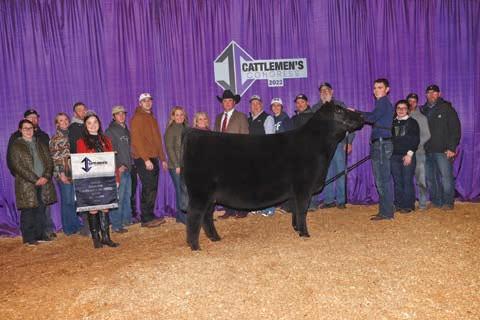
The operation runs on close to 800 acres; 500 acres dedicated to hay and another 300 slated for pasture. Regardless of what needs to be taken care of on the farm, Tyler, Cortney, their 8-year-old daughter Piper, and Kyle tackle the task. “We make all our own hay. We calve out all our own cows. We put in all our own eggs. We don’t do co-op herds, we do everything at the farm,” Tyler said. Kyle plays a very intricate part in the show cattle operation: feeding, clipping, breeding, and calving cows. Throughout the year they add one to two part-time employees to help in the show barn. On show day they recruit more than two dozen skilled cattlemen and women to help them fit their show string and their customers cattle.

“We strive to make sure that it is not just about winning, although we like to winit is good for our business, but we really try to help shape young people also.”
Sunrise Sunset Farm and Cates Farms operate in an area surrounded by corn fields. The location naturally limits their bull market, which spurred the Cates to develop a niche market of show cattle and elite bred females. The operations host a joint production sale called, Star Search, every year on the Saturday of Labor Day Weekend. Additionally, Sunrise Sunset Farm offers an online Angus sale each April and Cates Farms online Shorthorn sale is held in March.
The Cates’ customers seek out champions, but they are looking for more than show ring success. For the most part, people buying show cattle from the Cates are not farmers. They are people who grew up on a farm and utilized the lessons they learned in agriculture to build successful careers. They come to the Cates to purchase show calves for their kids in hopes of teaching their children lessons such as hard work, patience, and integrity.
“Parents can choose to buy cattle wherever they want, and they show cattle so their kids learn positive attributes that they can use throughout life. We strive to make sure that it is not just about winning, although we like to win – it is good for our business, but we really try to help shape young people also. And that has helped us sell cattle,” Tyler said.
If the Cates are shooting for the stars, then it may be safe to say they’ve caught them. They’ve produced champions at all levels in Shorthorn and Angus breeds. Most recently they bred the 2022 American Angus Association ROV Show Heifer of the Year and exhibited the 2022 American Angus Association ROV Reserve Show Bull of the Year. They were nominated for the 2023 Angus Herdsmen of the Year award. Their Shorthorn show string boasts just as many accolades and customers showing Cates Farms’
ANNUAL SALE: September 2, 2023
bred Shorthorns are sweeping national competitions.



The Cates’ operation runs at lightning speed and now they have one more factor to manage on show days. Their 8-year-old daughter, Piper, is old enough to compete in the show ring. “It’s special and stressful,” Cortney admitted. Cortney has judged showmanship all over the country so it is no wonder that Piper was Champion Prospector 1 showman at this year’s National Junior Shorthorn Show. Yet, seeing their daughter lead a show heifer in the ring serves as the ultimate reminder for Tyler and Cortney of why they are so passionate about their operation and way of life.
learn more catesfarms.com
sunrisesunsetfarm.com

Homo Black Homo Polled Purebred SM LCDR Witness 541C x
OMF EPIC E27
ASA#3317371
Homo Black Homo Polled Purebred SM WS All-Around Z35 x OMF Time Less B100




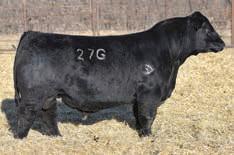


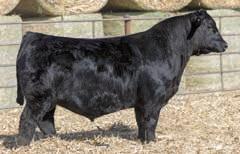
Owners :: Schooley Cattle & Little Shasta Ranch
SCHOOLEY HAGGARD
Schooley Miss 3000A 823F
Owners :: River Creek KS & Schooley Cattle

CRAWFORD GUARANTEE
ASA#3752744 Purebred AN Connealy Payraise x Crawford Ms Armory D40 Owners :: Schooley Cattle Co



AAA#19526770








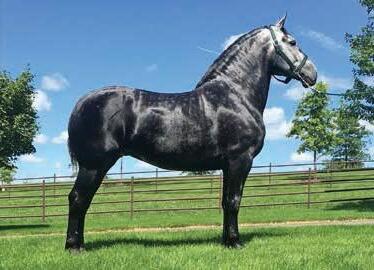






Health & Reproduction questions answered and explained.
contributed article by Dr. Vince Collison Collison Embryo and Veterinary Services, Rockwell City, Iowa collisonembryoservices.com
It is getting to be the time of year when we should start thinking about preconditioning calves. With historic calf prices, it’s even more important to do what we can to maintain calf health.
When we give our preconditioning vaccines to the calves it is important to have the calves be in their best physiological state to get the best results. This would probably be while the calf is on grass and still nursing its dam. At this time the calf is in a clean wide-open environment and has not undergone any stress from weaning.
As calves reach the age of 4 to 6 months, their maternal antibodies from colostrum are going to start to wane. This is one of the reasons why we will see more respiratory disease in weaned or newly purchased calves. By giving the first set of preconditioning vaccines preweaning, we can initiate some immunity prior to all of their maternal antibodies regressing. Ideally, calves will be 4 to 5 months of age at the time vaccine is given. The other advantage to doing it at this time, is that you can reap some of the benefit at weaning as well as the future buyer of the calves.
Our recommendations for preconditioning still are the 5-way viral vaccine along with a vaccination for 7-way Clostridium and H. somnus. We also like to deworm and treat for external parasites during the first round of vaccinations. Parasites are also a major cause of stress and immune suppression. Many producers want to wait to deworm after weaning since calves will be still on cows that are not treated for parasites. My feeling is that by deworming during the first round prior to weaning, your calves will have a better response to the vaccines due to the reduction of stress from parasitism. I am also amazed at how much calves will bloom prior to giving the second round of booster vaccine 2 to 3 weeks later, giving them even more advantage at weaning time.
Any surgeries that need to be done such as castrations or dehorning are best performed preweaning as well. Often producers are concerned with flies when performing these procedures in August and early September, but in my experience if you spray these surgical wounds with a screw worm spray they will heal very nicely.
Make sure that calves have had access to a good mineral prior to the time of preconditioning. If they have not, you may want to consider giving an injectable or oral drench trace mineral at the time of the first vaccinations to help the immune response. Also, response to vaccinations can deplete some of the trace mineral stores in the calf’s body.
For the 5-way vaccines we still prefer to give modified live vaccine. This is what the buyers want when they buy calves and is a requirement if performing vaccinations for the Iowa Gold tag program. If using modified live 5-way on calves still nursing cows, consult your veterinarian to see what your options are and what will work best in your case. Also, on the viral vaccines we often are asked if we should give an intranasal product in conjunction with an injectable product. In my experience this is not necessary and can be too stressful, causing the calves to be set back excessively. At this age we feel the injectable viral
vaccines are adequate.
When we booster calves, this is often done at weaning. At this point we recommend just giving a modified live 5-way viral and a 7-way/ Somnus for boosters. Or even just the 5-way viral by itself. By doing all of the other work on the cow, we get the booster vaccinations down to just 1 or 2 injections at weaning, making it a pretty simple process.

Also, during the post weaning phase a coccidiostat such as Amprolium can be fed to prevent the effects of coccidia. If a producer has had any problems with coccidia in calves, it can be prevented fairly well with this feed additive and it does not require a VFD. In addition to causing bloody stools, coccidia can also cause calves to be more prone to respiratory disease due to immune system suppression.
It is important for producers to work closely with their herd veterinarian prior to weaning to develop a program that works the best for their herd. Your nutrition, environment, closed herd or open herd are some of the many factors that can affect what you do for your herd and how well they respond. The herd veterinarian is there to help assess your program and determine what is best for your herd.
learn more collisonembryoservices.com

YOU'LL LOVE YOU'LL LOVE YOU'LL LOVE
SUNDAY SUNDAY SUNDAY SEPT 10 SEPT 10 SEPT 10 FROM HERE! FROM HERE! FROM HERE!
Sponsored by Northeast Iowa Angus Association
Bus leaves Comfort Inn at 7:30 AM and returns at 7:30 PM
7:50 AM 7:50 AM 7:50 AM
Hilltop angus 1367 200th St Independence, IA 50644
Craig & Mary Allen
Calving ease combined with strong growth and maternal traits.
decorah fish
hatchery
2321 Siewers Spring Rd
Decorah, IA
Feed the thousands of trout, enjoy the beautiful natural spring, view the trout stream, and spot the nest of the famous Decorah Eagle-Cam.
A.D.D angus Farm 5425 E Ave Arlington, IA 50606
Doug & Marcia Rueber
Raising registered Angus since 1963. Cattle are backed by 54 years of AHIR records and 20 years of DNA.
Smith Family farms
2417 348th St
Decorah, IA 52101
Eric, Dainna & Dustin Smith
Focused on performance tested Angus bulls and heifers that consistently combine phenotype and genotype.
RNDJ Farm
515 Great Owls Club Dr Postville, IA 52162
Dan & Nooch White
Docile, high performing, modern Angus that will excel in the show ring and barnyard.
Stop includes Prime Rib meal!
Millers Viewlawn angus
10029 381st Ave Mabel, MN 55954
Family owned since 1866. Registered Angus since 1903.
Stop includes Evening meal!
Northeast Iowa comm college

1527 Highway 150 Calmar, IA 52132
Tour through the beef and dairy facilities and learn how the college is using Angus in both programs.
Thank you to our sponsors!
PLATINUM PLATINUM PLATINUM Channel Seed
AGAR Transportation, Idaho Rockin' 4 Express, Idaho
GOLD GOLD GOLD
VitaFerm
Hubbard Feed
Stockman Magazine
American Beef Producer Magazine
A charter bus is available until filled. Participants are also welcome to drive themselves.
Headquarters
transportation Comfort Inn & Suites: 2100 Swan Lake Blvd, Independence, IA Block of rooms reserved until Aug 16 for Sept 9-10 Call 319.334-6400 to book
at
cost
$40/person Participants aged 18 and under are free (but must register).
SILVER SILVER SILVER
Postville Vet Clinic Farm Credit Services, Decorah Driven Embryos LLC, Justin Helgersen
Ward Livestock
Photography
Veterinary Associates of Clayton County

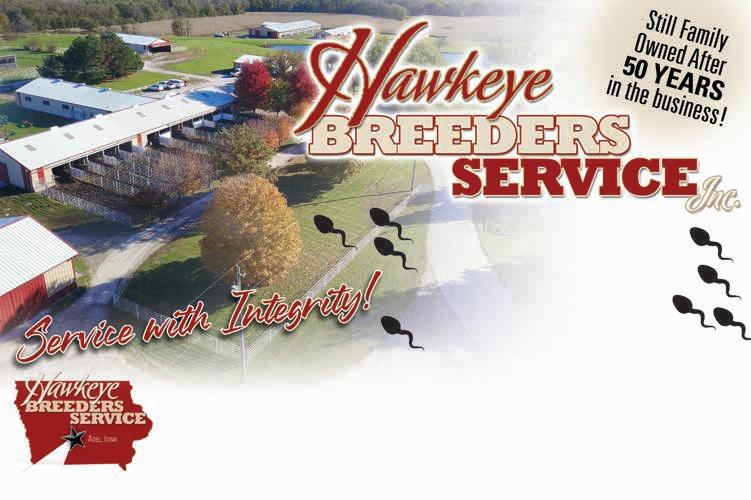



I’m a fourth-generation beef producer. I grew up on a farm my grandfather, Frank Ogren, purchased in the 1920s in Sac County, Iowa, which is the site of our sale today. Both sides of my family were cattle feeders, and the highlight of the year was to take feeder cattle by train to the International Livestock Exposition in Chicago. In 1932, my grandfather, Edwin Turin, won the champion carload of Herefords. So, the love of raising and

This trait has been handed down to my three sons: Dustin Carter, Tyler Kenny, and Dru Kenny. We grow corn and soybeans and raise registered Angus cattle on our farms near Odebolt and Schaller. Brian and I bought our first registered Angus cows in 1990. Brian always said the pigs bought the cows and then I say, we sent the pigs down the road!! The boys enjoyed showing registered Angus heifers and our herd grew. Since we live in the center of corn country, we wanted a small herd of top quality. We use extensive artificial insemination and embryo transplant to produce the best genetics possible. We have been selling registered Angus breeding stock
We have been selling our bulls and top females at consignment sales and expos across the Midwest and Denver for 26 years. Our family ventured out to have our own sale on the farm in 2017. Dustin is the auctioneer, Dru gives the welcome, and Tyler helps clerk and sets up the lots. It’s awesome to have all three sons on the sale block. Dru came back to the farm after graduating from South Dakota State University. He has a great eye for the best phenotype combined with top performance. He is also in charge of our social media and marketing to keep Kenny Angus news in front of the public. I give him much of the credit for moving Kenny Angus to new high levels. It is a team effort.

Now we take around half the cows to the Sandhills near Atkinson, Neb., to graze for the summer. We calve early in December, so we can offer more mature bulls to our customers. This allows us to wean early and send bred females to Nebraska. A passion for cattle, now Angus cattle, runs deep in our heritage!
Growing up I spent most of my free time outside with my dad and the cattle. I enjoyed showing calves from an early age. So, I didn’t spend much time in the house learning to cook unless it was a baking project for the fair. I did get many tips from my mom and her sisters. My mother-in-law, Judy Kenny, is an amazing cook so I have received many of her recipes for our family. Since I continued to help on the farm and with livestock, I needed quick recipes!!
What is your favorite cooking tip/trick?
Try to plan ahead with something in the Crockpot or a meal that you put together the night before. Double batches to freeze or have for the next day are helpful too.
What is your least favorite job in the kitchen?
Like most people, I’m not a fan of cleanup!
learn more kennyangus.com for printable recipes stockmanmag.com
1 pkg. King’s Hawaiian rolls
2 green bell peppers
1 onion
1 pkg. fresh mushrooms
Steak (sirloin or ribeye), thinly sliced
Sue Kenny
mayonnaise to taste
provolone cheese slices
melted butter
Slice an entire package of King’s Hawaiian rolls, then pull apart in half and spread light coat of mayonnaise on the rolls. Dice the green bell peppers, onion, and fresh mushrooms. Preheat oven to 350 degrees Fahrenheit. Put bottom of slider buns in 9x13 pan. Place cooked, thin slices of steak aside. Sauté pepper, onions, and mushrooms until tender. Add layer of steak followed by provolone cheese and sautéed veggies. Place top slider buns over the layers of steak, cheese, and veggies. Brush the top of the buns with melted butter. Cover with foil and bake 10 minutes, remove foil and bake another 10 minutes. ENJOY!!
2 T. vegetable oil
1 lb. boneless top sirloin steak, thinly sliced into bite-size pieces
½ c. onion, sliced
1 T. garlic, minced
1 T. ginger, minced
1 12 oz. bag fresh mixed vegetables stir-fry medley
1 6 oz. pack mushrooms, sliced
1 8 oz. can water chestnuts
1 red bell pepper, sliced into strips
2 T. soy sauce
½ tsp. red pepper flakes
1 pack stir-fry seasoning mix
Steamed instant white rice for serving
In a large skillet or wok, heat 1 tablespoon of vegetable oil over high heat. Add the beef and stir-fry for about 3 min- utes. Remove beef and reserve. To the same wok, add the remaining oil and sauté the onions, garlic, and ginger. Add the stir-fry vegetable medley, mushrooms, water chestnuts, and red bell peppers. Stir-fry for about 3 minutes and return the beef to the wok. Stirring constantly add the soy sauce and crushed red pepper flakes. In a small bowl, whisk the stir-fry seasoning mix with 1/8 cup water until combined, then add 2 teaspoons of cornstarch to thicken. Add the seasoning mix- ture to the wok and stir for another 3 minutes. Serve with steamed instant white rice.
1 lb. ground beef
1 T. oil




1 onion, diced
2 to 3 cloves of garlic, minced
1 green bell pepper, diced
Sue Kenny1 10 oz. can Rotel tomatoes
1 8 oz. pkg cream cheese
1 packet taco seasoning
salt and pepper to taste
1 14.5 oz. can beef broth
Add oil to a large pot or dutch oven. Brown the beef, onion, and garlic over medium heat. Add the bell pepper, Rotel diced tomatoes, cream cheese, and spices. Stir for 4 to 5 minutes until tomatoes are soft and cream cheese is mixed through. Pour in broth and reduce to low to medium heat. Simmer 15 to 20 minutes or until desired thickness. Top with fresh avocado, sour cream, shredded cheese, fresh cilantro, and jalapeno. Finish with a drizzle of lime. Make a bigger batch because it doesn’t last! You can put it in a Crockpot to have ready when you come in from chores.
Kenny Angus Bull & Select Female Sale


March 8, 2024 near Odebolt, Iowa













he fledgling group of Chianina breeders in the U.S. began having sales of breeding stock early on, and soon were holding regional sales and then national sales. The first public sale of Chianina genetics was at Schearbrook Land and Livestock’s, Ozark, Missouri division in April 1972. This sale, like others that followed in 1972 and early 1973, consisted mostly of beef and dairy females bred to Italian Fullblood Chianina sires. The first exclusively Italian Fullblood Chianina sale in the U.S. was hosted in Dallas, Texas, on July 31, 1976 by Walter G. Mize’s Ranches at Cleburne, Texas and Pass Cattle Company in Dallas, Texas.
The first ACA National Sale was held September 8, 1973 at the Downtown Hilton Inn, Kansas City, Mo. ACA members nominated half-blood Chianina heifers in early 1973 with Dr. Jack Phillips screening the 55 females for this initial sale. The high seller was one of the earliest bred half-blood heifers in the U.S.; a safe-in-calf Diaceto I x Santa Gertrudis consigned by Italian White Cattle Breeders, Tannehill Ranch. She was bought by Twin Wheels Chianina for $27,000. The sale averaged $6,322 in front of
an audience of nearly 1,000 people.
For the next 3 years the ACA regions hosted summer field day shows where halter-broken ACA registered heifers were shown and judged with ACA National and Regional sale candidates selected. For those regions not having sufficient numbers of nominated animals to hold field days, ACA staff members made on-farm selections.
John Coble, now 87, has been involved with Chianina cattle for 53 years and recalls working with those early sales. “I was one of the first breeders in this country; when the first semen became available from Italy, I bought some. When Jack Phillips was hired by the ACA, he hired me to help with sales,” John says.
said, ‘Never again!” John recalls.
“Then we had several national sales. Richard Koonce was one of the ACA staff members from 1972 through 1980. He and I put thousands of miles on the ACA car – a new Fiat that Jack Phillips bought. We went from farm to farm to look at cattle that were nominated for the national sale at Louisville. We practically drove the wheels off that little car!” Linda Work and Alice Burney worked in the ACA office for many years and did the registrations. They traveled with Richard and John to sales and kept all the books.
One of the problems he dealt with was temperament of some of the cattle. “Sam Barr had a sale in Denver and the cattle were so wild that one jumped out of the sale ring and broke a leg. We had 4 or 5 regional sales that first year and I went to every one of those sales and managed them. After what happened with the animal that broke its leg, one of the criteria for bringing cattle to a sale was that if you can’t handle them, you can’t bring them. Jack
Phillips“There were a lot of really good bulls being used during those early years,” says John. “Ferrero, Friggio, Faletto and Lombard were great bulls. I raised some Fullbloods myself at that time. Breeders were having sales and sending cattle to the national sales. Richard and I were doing a lot of traveling and accepting cattle for those sales. The number one thing we checked for was temperament. Jack Phillips told me we couldn’t judge the cattle for people, but we could judge their disposition and we never did have another accident due to disposition,” he says.
photos courtesy American Chianina AssociationHe says one of the problems with disposition sometimes was the way the cattle were being handled. “It occasionally got out of hand because some of the guys at the sale barns would hit them with hot shots just to see if they could jump fences; they thought that was fun. That sure didn’t help, and we had to sort through some of that. When I went to work later at Willow Oak we had a bunch of wild ones and started culling hard. For 33 years we had zero tolerance for bad disposition and now we don’t have any wild cattle. It just takes selection, in any breed,” he says.
“Those early years, however, were an interesting time in my life because I’d never managed shows but I became a manager pretty quick!” John says.
The 2nd ACA National Sale was one of the highlights of the inaugural 1974 North American Livestock Exposition (NAILE), in Louisville, Ky. The sale offering was comprised of heifers that were 50% and 75% Chianina. Subsequent ACA National Sales conducted under this selection process were held at the 1976 Southwestern Stock Show in Fort Worth, Texas, and the 1976 American Royal in Kansas City, Mo. These two sales included the first
sales of Italian Fullblood Chianina originating from Canada.

Beginning at the 1977 NAILE, the ACA had an Open Show for all ACA members. Breeders were encouraged to pre-nominate sale cattle selected from the Open Show entrants. The first sale was topped
by the Grand Champion Purebred (Fullblood) Female, Logga White Lily I, purchased by Kohler Farms, Kohler, Wis., for $18,000.
In 1974 the ACA Board began a National Steer Show Award program. At a few nationally chosen shows, the grand champion steer over all breeds, if it was a registered Chianina, was awarded $5,000. This was the highest steer show prize money ever awarded by an American breed association. Eligible shows the next few years were the International Livestock Exposition in Chicago; the American Royal in Kansas City, Mo.; the National Western Stock Show in Denver, Colo.,; the North American Livestock Exposition in Louisville, Ky.; the Southwestern Stock Show in Fort Worth, Texas; the Grand National Exposition (Cow Palace) in San Francisco, Calif.; AK-SARBEN in Omaha, Neb.; and the Eastern National in Timonium, Md.

Richard Koonce says 1975 was the breakout year for Chianina-sired market show steers. “Chianina steers captured championships at 7 state fairs. Jeff Gropper, Grinnell, Iowa was the first exhibitor to
receive the ACA $5,000 National Steer Award for his American Royal grand champion. This was the first ‘clean sweep’ of the other national show with grand champion winners by Kraig Schilder, Malcom, Iowa (North American); Greg Gruhn, Lanark, Ill. (Chicago International); and Greg Hilbert, Algona, Iowa (1976 National Western). From these 1975-76 winners – until the program was discontinued in 1980 the ACA presented twelve $5,000 steer awards to steer owners.”
The ACA National Steer Award program ignited interest in using Chianina semen on other breeds –mostly Angus or Herefords. “Italian Fullblood semen was first used, then more black percentage Chianina/Chiangus sires as the 1970s progressed. This ACA national program greatly increased interest in the Chianina breed, spawning an entirely new energized club calf industry,” says Koonce.
“At the 1973 Chicago International Expo, a pen-of-5 half blood Chianina x Angus steer calves bred and owned by Rocking J Ranch and Vic Gentry, Cody, Neb., were grand champions of the feeder calf show. Another half-blood Chianina x Angus pen entered by Duane Exline and Lavern Massman, Exline, Iowa, were reserve champions. Chianina-sired steers throughout the 1970s and beyond dominated feeder calf shows at the Chicago International, North American, American Royal,
Grand Champion Steer – 1975 North American International Livestock Expositionthe National Western and Arizona National shows,” he says.
A strong club calf market was created for Chianina-sired steer calves led by nationally recognized cattlemen including Jerry Adamson, Rocking J Ranch and Larry Hollers, Cody, Neb.; Fred and Mike Hartman, Wood River and Tecumseh, Neb.; Ty Hullinger, Harris, Mo.; Gib Yardley, Beaver, Utah; Knic Overpeck, KO Cattle Company, Clinton, Ind.; Horsley Brothers, Toulon, Ill.; Jack Stoltz Exotics, Elgin, Neb.; the Dick Carlson Family, Mile High Chianina, Denver, Colo.; Hilbert Bros., Algona, Iowa; Lautner Farms, Jefferson, Iowa; Paul Clapp, P Bar C, Searsboro, Iowa; Bobbie May, Mineral Point, Wis.; Charles J. Burk, Panhandle, Texas; Jensen Cattle Company, El Reno, Okla.; Howard King, Holly, Mich.; and Jeff Miller, Cutler, Ind..
At the 1977 North American International Exposition the first ACA open cattle show was established. “It remains the annual ACA National Show, these last 45 years. The original show drew over 300
entries dividedinto 2 divisions – Percentage Chianina (1/4 to 3/4 Chianina) and Purebred Chianina (7/8th to Italian Fullblood). Over many years several different show division methods have been utilized reflecting the ACA members’ breeding and marketing endeavors,” Koonce says.
In conjunction with the 1978 and 1979 ACA National Shows, the first ACJA Junior Heifer Shows were held. The 1980 ACJA heifer show was at the Missouri State Fairgrounds, and these annual ACJA Junior Heifer Shows were held yearly at varying show venues across the country.
1986 Inaugural Show
• Big Bull Ranch - Canadian, Texas
• Black Champ - Waxahachie, Texas
• Boone Farms - Ardmore, Alabama
• Chadbourne Ranch - Bronte, Texas
• ChiArrow Cattle - Silesia, Montana
• Circle E Farms - Fort Deposit, Alabama
• Greenwell Chianina - Decatur, Alabama
• Horsley Brothers - Toulon, Illinois
• Jensen Cattle Company - El Reno, Oklahoma
• Keller Ranch, Brewester - Nebraska
• Kennard Land & Cattle - Mt. Calm, Texas
• Kissee Livestock - Springfield, Missouri
• Liberty Lanes Ranch - Dallas, Texas
• McMorries Farms - Hereford, Texas
• P Bar C - Searsboro, Iowa
• Pleasant Valley Ranch - Ogden, Utah
• Rocking J Ranch - Cody, Nebraska
• Stanford Farms - Lebanon, Tennessee
• Talmo Ranch - Talmo, Georgia
• Walco Farms - Stanford, Kentucky
The first state fair open show was held at the 1978 Missouri State Fair in Sedalia. Next was the Southwest Region Show that Fall during the Texas State Fair in Dallas, Texas.
Moving into the early 1980s, other state fair open shows were started at the Illinois, Iowa, Kentucky, Nebraska and Ohio state fairs.
“In 1982 at the National Western Stock Show, ‘On-the-Hill’ Open and Junior Heifer Shows were established. Another popular national show venue for ACA members hosting similar breeding cattle shows is held during the Southwestern Stock Show, Fort Worth, Texas,” says Koonce.
Dr. Jack Phillips created the ChiAngus Classic Show in 1986 with a futurity style format sponsored by 20 ACA Chiangus breeders. Show entrants were nominated through these breeders. The 20 sponsors each contributed $5,000 toward the $100,000 show purse.

Chianina female sales were conducted at the 1973 to 1975 National Western Stock Shows. “During 1975 the ACA Special Activities Director, John Coble, was hearing increasing interest from cattlemen seeking to find percentage Chianina bulls. Coble lobbied for adding bulls to the next Denver female sale. Only 15 three-quarter Chianina bulls of breeding age were cataloged for the January 1976 sale. Though the morning sale order show was sparsely attended, having to compete with the market steer show, by that evening’s sale the Livestock Auction Arena was filled to capacity. Thirteen bulls were sold, averaging $1,123 with a top of $5,000 for a three-quarter Chiangus bull,” Koonce says.
The die had been cast; farmers and ranchers from all across the U.S. wanted to have Chianina bulls presented at Denver. “So, from 1977 through the 1980s the ACA National Western sales were all bulls. From 57 bulls in 1977, and 80 bulls in 1978, the number of sale entrants exploded over the ensuing years to over 250 bulls by 1981. With increased numbers, a greater
sifting of bulls occurred, yet over 100 bulls sold annually from 1980 to 1985 with the most at the 1981 sale – 161.92 lots (partial interest bulls). The two highest averaging sales were the 1980 sale (101 bulls at $4,665) and 1982 when 121.5 bulls averaged $4,855. Over the first decade of National Western ACA Bull Sales, over 850 individual halter-broken and fitted Chianina bulls were merchandised.”
Over the years many families, and multiple generations, have enjoyed showing Chianina cattle.

Ventura Farm – Ken and Deb Geuns have participated in many shows. “I personally have been involved since 1977,” Ken says. “I was in partnership with Dr. Harlan Ritchie, and this was the main reason I ended up in Michigan. I was from Illinois and decided to go to graduate school at Michigan State University because of people like Dr. Harlan Ritchie and Dr. David Hawkins. I started grad school in 1976 and Harlan and I developed a close friendship. He already had some Chianina cattle in partnership with Myron and Kathy Danner. That was the beginning of Ventura Farm. Ventura Farm’s ACA number (486) is the fourth earliest of all active ACA members.”
When Myron and Kathy moved to Nebraska with the mature cows, Harlan retained the 1978 heifer crop at Ventura Farm. “We started a partnership with those young females and a package of Simmental cows Deb and I bought,” Ken says. “We bought Ventura Farm after Dr. Ritchie passed. This farm has always had Chianina cattle — and still has Chianina composites. It gives us great satisfaction to know that we can trace most of our current cow herd to those original
“There were very few years since 1979 that we’ve not taken cattle to the North American in Louisville for the National Chianina Show. We’ve spent most Novembers in Louisville. Now we are getting on in age and this year we just went to watch the shows. We were fortunate to be very successful with our cattle — whether through luck or skill. The farm has been involved with 8 National Champions or Reserve National Champions,” Geuns says.
“Our heart has always been with Chianina, though we’ve had Simmental, Salers, Maine-Anjou and a variety of breeds. There were many years in Louisville that the Chianina show had the most spectators. People were curious and interested
Ken, Deb & Christina Geuns - Bath, Michigan A Ventura Farm display could always be found in the Chianina stalls in Louisville. They were a mainstay at the show for many years.in this very different breed. The grandstands were packed, and we’d have 300 to 400 head of cattle in those shows,” Geuns says.
“Unfortunately, that’s not the case now. There are many reasons, and one is that it’s gotten so costly to go to the shows. We used to go to Louisville and be there for 10 days. That’s harder to do now, with motels costing more than $200 a night, etc. The Chianina open show has become quite small.”
Yet through the 1980’s it was very exciting, regarding what those cattle could do. “We’ve always been committed to them. My wife Deb has been extremely active in the Ladies Auxiliary for many years. I was on the ACA board of directors for 6 years and served as chairman of the board for 2 years. As a family, we were very active. Our daughter Christina was a member of the National Junior Chianina Association board when she was a youth,” Geuns says.
Christina won Champion Chiangus Female at the National Junior Show in 2001 and Champion Bred and Owned Bull in 2004. “She had several Champion and Reserve Bred and Owned Females. When she had an opportunity to show at other breed junior nationals, Christina was determined to stay with the Chi’s. She was selected “Herdsman of the Year” at the National Junior Chianina Heifer Show in 2004,” Geuns says.
The Culp Family – Ken Culp III has been involved with Chianina cattle for many years and these cattle became a family project. “On August 31, 1980 I drove to Kearney, Mo., and purchased a ¾ blood Chiangus bull calf from Blue Sky Farm. They were preparing to disperse their herd. It was a father and son team — Sam and Jack Barr — and Jack was going to be CEO of the ACA. The board of directors determined that he could not own

Chianina cattle; it would be a conflict of interest,” Culp explains.
“On September 1, Blue Sky Farms would inventory their herd and catalog them for a dispersal sale, so on August 31, I purchased a bull we named Blue Sky Senator. We showed him at Louisville that fall and he was Calf Champion. Back then, there were two divisions — fullblood and percentage. He won the junior calf division of the percentage show. We kept that Chiangus bull until he was 8 years old; he started the basis of our Chianina herd.”
In 1994 Ken was asked to judge showmanship at the National Junior Heifer Show in Richmond, Ind.. “I had so much fun with that, and had such a good impression about the junior program that I decided my kids were going to be junior members when they got old enough. In 1995 I went to Iowa and judged showmanship again, along with several other contests,” Culp says.
“In 2000 our oldest daughter was 11 and had a Chiangus heifer. The Junior National was held at Louisville, Ky., at the Exposition Center. I officiated at the livestock judging contest at that show. Our kids participated in many shows; we’ve attended every Junior National heifer show since then. Our three girls (Brittany, Kelsey and Laurel) participated in 19 consecutive National Junior heifer shows, all three were National Queens, and all three served two terms on the junior board,” he says.
“We believe that the best way to repay service is to provide service; we’ve all been active in events that support the ACA. The girls were busy showing cattle and we’ve shown Chianina and Chiangus, but primarily Chiangus. Laurel’s last year as a junior was 2018; she showed a bred and owned Chiangus heifer that was Reserve Grand Champion at the Chiangus Classic, Reserve Grand Champion in both
the junior and open show at the North American, Grand Champion Bred and Owned Chiangus Female at both the National Junior Heifer Show and the North American International Livestock Exposition, and was 5th overall at the National Junior Show. Laurel also won showmanship that year. It was a good way for Laurel to go out and a great way for the Culp sisters to end their 19-year run in the National Junior Chianina Heifer Show and junior program. Laurel and her sister Kelsey raised that heifer and showed her mother.”
That was the beginning of the next generation involved with the breed. “Laurel’s last year was 2018 and in 2019 the next generation (Kelsey’s daughter Kennedy) entered the show ring.
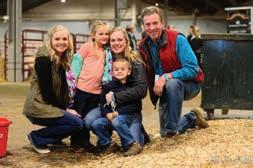 Editor’s Note: This is Part 2 of a multi-part series. Watch for Part 3 coming soon. learn more chicattle.org
The Culp Family was recognized at the 2018 Junior National for attending 19 consecutive NJHS shows. Pictured (l to r): Derek Evans holding Brooks, Laural (Culp) Taylor, Ken Culp III, Brittany Culp & Kelsey (Culp) Evans.
Editor’s Note: This is Part 2 of a multi-part series. Watch for Part 3 coming soon. learn more chicattle.org
The Culp Family was recognized at the 2018 Junior National for attending 19 consecutive NJHS shows. Pictured (l to r): Derek Evans holding Brooks, Laural (Culp) Taylor, Ken Culp III, Brittany Culp & Kelsey (Culp) Evans.
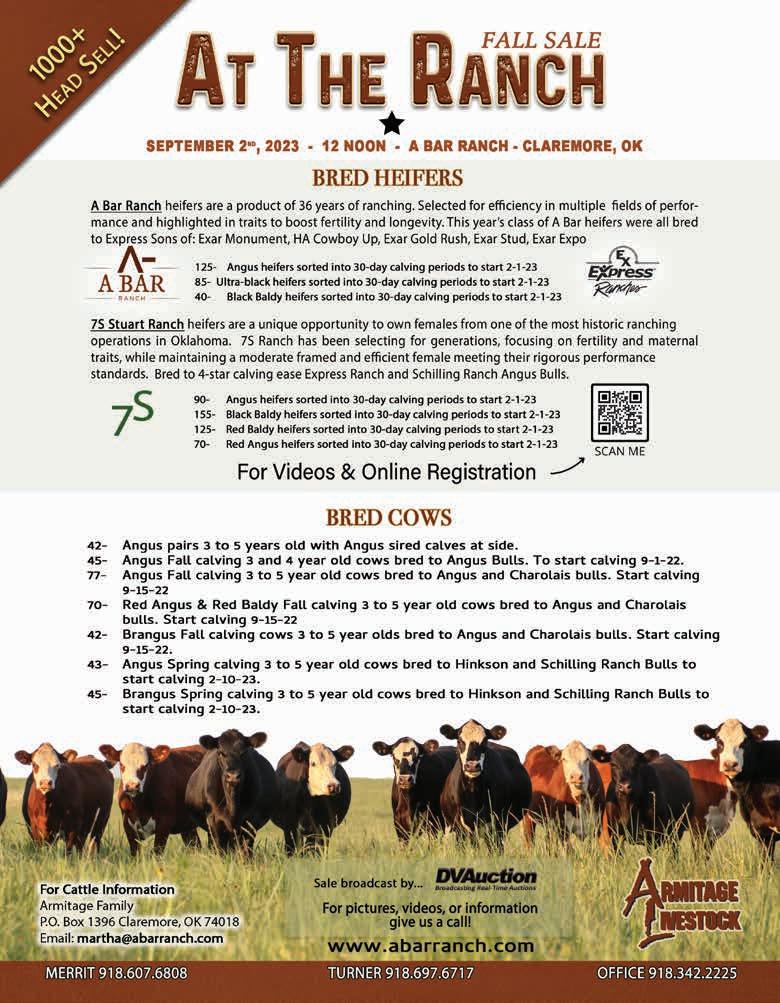

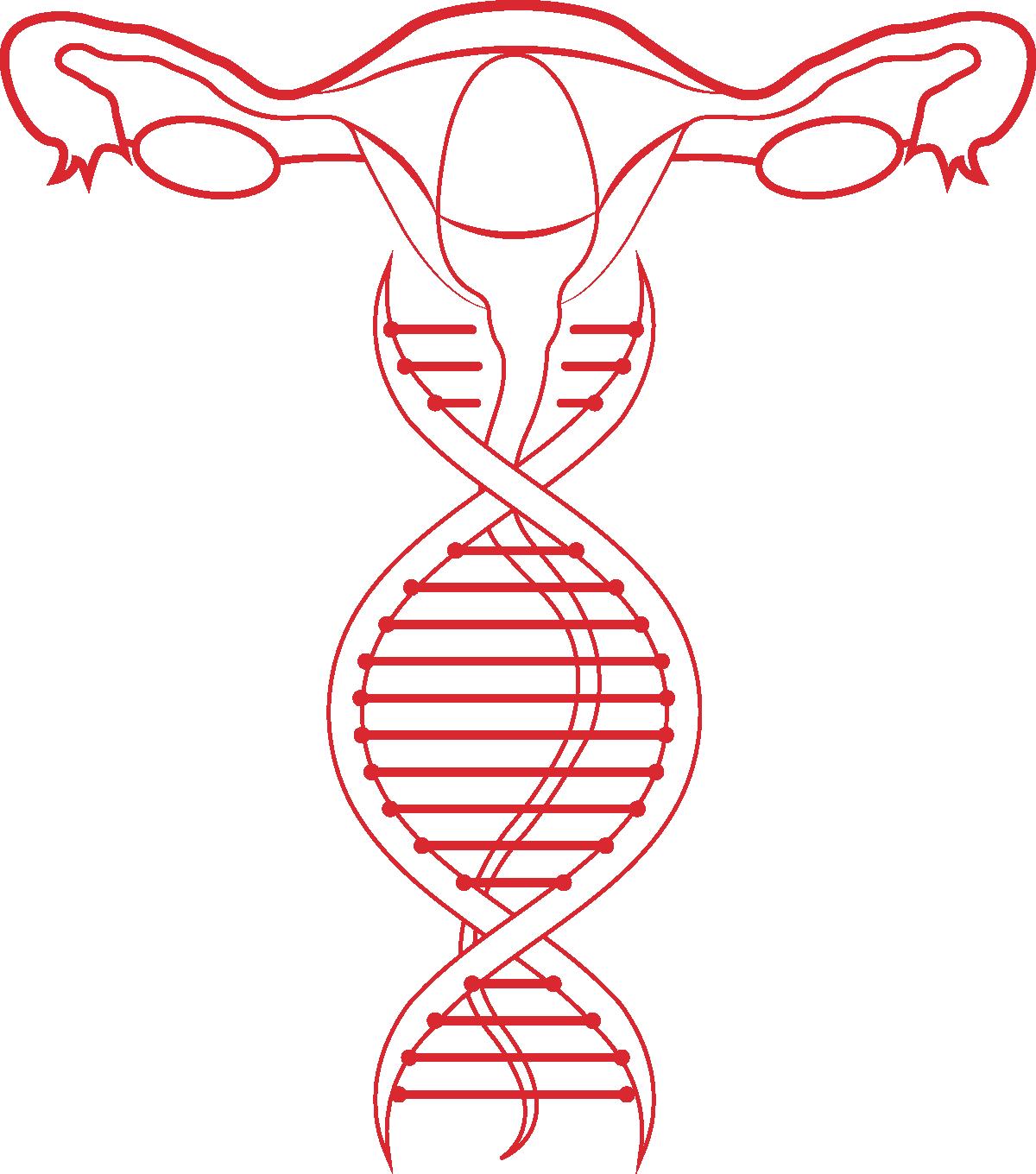


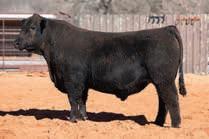

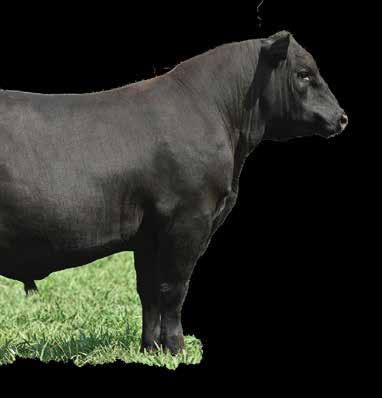
Adjustable
THE NEXT GENERATION FITTERS GUARD
• The new design of the aluminum front upright features five horizontal cross bars resembling the functional design of an aluminum front stall panel. This enables numerous tie location heights. It also allows for you to attach Straight Up bars. Measures 66” tall x 42” wide.
• Black powder coated round aluminum side bar restraints.
Straight Up Bar Compatibility
PRECISION FITTING TOOLS
These high-performance bevelled edge shears are the go-to for elite fitters with precision in mind. Offered in two options regular or bent handled. 7.5” right handed.
• A new, reinforced adjustable base is constructed of steel tubing to prevent breakage.
• Base easily adjusts in length from 18” to 46” away from the front upright to the perfect side bar location for all sized cattle. The adjustable length base is safer for cattle hooves.
• When not in use, the base can be folded up, out of the way.
• Easy set up. Simply attaches to the front of barn stall or trailer with Handi Straps. Must be secured in place before use. Folds easily for easy transport. • For use only on broke animals.

this fat cattle deal to continue an upward trend going into the new year and into spring. How high we can go, that is the million-dollar question!

It seems just like yesterday that I was writing my last article and the kids were ready to get out of school and here we are already with the summer winding down, state fair season upon us, and the kids ready to start school again. I know it sounds cliché, but the summer has flown by and is gone in the blink of an eye. Now let us look at what we have been seeing in the barns and the markets.
s I wrote this article, we have received our first snowstorm of the winter and my four little ones could not wait to throw on their snow pants and go play in the white stuff! Me on the other hand, not so excited about leaving the warmth and comfort of my office. It is because they are looking forward to joy and fun and I am dreading frozen waters and/or sick cattle. Either way, it is safe to say that winter is upon us!
Now to look at some of the market reports that we have been seeing in the barns. The fat cattle market has been on a hot streak for several weeks, until this past week, when we experienced a slight dip in the market. We have seen some highs in the mid to high forties, but these have been some extremes. Most cash cattle in the country have been trading at forty level or slightly higher the past couple of weeks. I expect there to be a few bumps in the road, but I expect
Well, when I left you in May I said that the fat cattle market was taking off and it sure did. As we got closer to Memorial Day and grilling sea son, we saw excellent demand and you can go back and look and I said, “I made a bet with a good friend of mine yesterday that sometime in the middle of May that somewhere, someplace, on the right day we will see a fat animal go through the ring at $2.00.” Well, I was wrong, it did not happen until the first of June. We had several reports in the first part of June of a set here and there of cattle bringing over $2.00. While the cash market in the country never came close to that, there were sev eral cattle sold in the 90’s for sever al weeks here in the Midwest. The market has cooled off with new crop calves coming to town, but just like
The higher fat cattle market is driving a higher price for the feeder cattle market as well, even with the higher feedstuff inputs. We have seen some front end big strings of 800 pounds bringing well into the sixties and some 600-pound cattle bringing into the seventies and eighties. Once again these are some extreme tops. We have been trying to fill up our own lots as fast as possible, as I am not sure the feeder cattle are going to get any cheaper. We have been able to find cattle at cheaper prices than that and so when we do projects they are in the black.
The cull cow and bull market has lagged the fat market, as from all reports there have been around six

Kirk Lynch, Lynch Livestock Inc., Waucoma, IA Kirk is the Beef Division manager for Lynch Livestock Inc. and oversees all aspects of their backgrounding and cattle feeding operations throughout Iowa and Kansas. He is also deeply involved in the newly reopened Humeston Livestock Exchange in Humeston, Iowa. In addition, Kirk and his wife Mary own and operate Heartland Simmentals in Northeast Iowa, which is a seed stock operation that consists of 500 registered Simmental and Angus cows. They have four children: Gabrielle (8), Brayden (7), Vivian (5), and Bianca (1).
percent more last year, making supply of cows. down, which be into next year, cow and bull with the same market.
The breeding been up and cently, I heard commercial pairs $2,000 and then can buy all the I want for $1,200 are looking to now is the time reasonably priced with increased are going to be ply over the next Wishing everyone Christmas and


EXCHANGE
Humeston, Iowa 641-877-6092









to get a closer look at how beef makes its way to consumers. Other tours being offered include Gatorland, Kennedy Space Center, Wild Florida and more. “Being in Florida, we knew that members might want to bring their families for a few days to experience the sights,” said Caitlyn Brandt, director of events and junior activities.
Registration is now open for the 2023 Angus Convention held in Orlando, Florida.
With the theme of “Experience Angus Convention”, this year’s convention promises unparalleled educational opportunities, industry insight and a solutions-based trade show. Registration is now open for the highly anticipated 2023 Angus Convention, the premier event for cattle producers and industry professionals.
This year’s Angus Convention will take place from Nov. 3 to 6 at Rosen Shingle Creek Hotel in Orlando, Florida. For the first time, Angus Convention will be held in the Southeast.

“While the average consumer may think of beaches and amusement parks when they think of Florida, we know the state is rich cow country,” said Mark McCully, chief executive officer of the American Angus Association.
Attendees can look forward to a lineup of engaging sessions, renowned speakers and interactive workshops. Not to mention the large variety of tours this year makes it a family-focused event.
Sign up for the National Angus Tour to learn more about Florida’s cattle industry or attend Beef Blitz
The first gathering of all attendees will be at the Grand Opening of the trade show on Friday evening. One of the highlights of the general sessions will be a session focused on genomics. “Genomics has transformed how we think about breeding cattle today. But it’s not just the Angus world that has seen change,” said McCully.
Throughout this year’s Angus Convention, educational sessions will introduce topics for attendees to learn more about production practices, new technologies and marketing. Angus University sessions on Sunday morning are designed to pique the interest of any size cattlemen from across the country.
With production topics like Artificial Insemination (AI) best practices, fly control and parasite resistance, association members are encouraged to invite their commercial cattleman customers. “The convention isn’t just for Angus breeders,” said Brandt. “All users of Angus genetics will find something of interest.”
Attendees can visit the official convention website at www.angusconvention.com to secure their spots and access additional information about the event, including the schedule, tours, accommodations, and exhibitor details.
-Written by Julie Isbell, Angus
CommunicationsKANSAS CITY, Mo. – Aaron Friedt, Mott, N.D., joined the American Hereford Association (AHA) as the North Central region field representative as of May 8.

As an AHA field representative, Friedt represents Association members in the region and assists with AHA activities and services. In addition to attending Hereford sales and events, he serves as a resource for Hereford breeders interested in using advertising and other marketing services provided by Hereford Publications Inc., while continuing to build relationships industry-wide. Friedt helps Hereford breeders and commercial users of Hereford genetics use AHA promotional and marketing programs to add value to their cattle.
“Aaron is a great young man with extensive knowledge of the breed and marketing Hereford genetics,” says Joe Rickabaugh, AHA director of seedstock marketing. “We are excited for the talent and promotional experience he brings to the AHA team of field representatives. Growing up in a Hereford family, he knows the value of Hereford genetics for the entire cattle industry. We are eager to welcome Aaron to the AHA team.”
Friedt has a variety of livestock


















marketing skills, from the auction block to the pasture. He is a former online sales manager for the online bidding platform The Livestock Link. Friedt graduated from the Western College of Auctioneering in 2016, and has marketing, sales and consulting experience. He has deep roots in the Hereford breed and helps manage his family’s ranch, Friedt Herefords.
“As the newest Hereford field representative, I’m excited to assist in the breed’s advancement and use my past experiences in the auction industry to help producers market their Hereford genetics,” Friedt says. “I believe the Hereford breed provides benefits to all facets of the cattle industry, and I look forward to helping promote the breed. The current market environment will provide plenty of opportunities for the Hereford breed in both the commercial and seedstock sectors, and I’m excited to be part of it.”
Friedt’s territory includes the states of Kansas, Minnesota, Nebraska and South Dakota. He can be contacted at 701-590-9597 or at afriedt@hereford.org.
schools in Grand Island, Nebraska.
More specifically, most of the backpacks, headphones, crayons, pencils, erasers and other school supplies given by exhibitors at the National Junior Angus Show on July 1-8 have been directed to Howard Elementary School, a Title I school in the district.

“We would like to thank the participants of the National Junior Angus Show for their school supply donations to Howard Elementary,” said school principal Jessica Schroeder. “Your donations help students have supplies to start the school year. The beginning of the year is an exciting time and having new supplies to use aids in that excitement.”
Angus junior member, Cailee Flood, said why she was drawn to contribute to the 2023 project.
Public Schools, said the additional dollars will allow the district to fill in some gaps other schools in their district might have during the academic year.
Angus Impact is the official community service program of the National Junior Angus Association.

– Written by Sarah Kocher, Angus Communications
Junior members serve local schools with supplies, donations at the 2023 National Junior Angus Show.

A little generosity goes a long way, especially when hundreds of people give a little. That truth came to life with the 2023 “Service to Schools” Angus Impact project, which resulted in the gathering of over 700 items and packages of supplies, in addition to a monetary donation, being collected for public
“I feel like for a lot of kids, school is hard enough to begin with, whether you aren’t able to afford the supplies or whatever the reasoning may be,” the California junior member said. “I feel like it’s really important that we’re able to support them like that and be able to provide them with supplies that they need so maybe they can have an easier time getting their education.”
Flood along with other California Junior Angus Association members organized a fundraiser totaling $600 through a 5K race their state hosted at the national show. Participants could elect to donate $5 on top of the regular race fee to benefit Howard Elementary students, and 65 of the 95 participants chose to donate the $5 amount or more.
Because of their generosity, Angus juniors and their families made an even larger impact than they set out to make. Jennifer Worthington, chief of community and stakeholder engagement with Grand Island
Members of the California Junior Angus Association pose with J. Gordon Clark, far left, of the National Junior Angus Association board of directors and Grand Island Public Schools representative Jennifer Worthington, who is holding the donation check.
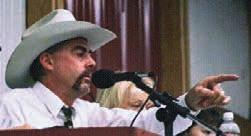












In our third year of participation, The Stockman is thrilled to announce the following Livestock Publications Council 2022 Awards Contest:


Category 18 - Technical Article
‘Self-Care for You and Others’ by B. Lynn Gordon

March 2021
FIRST PLACE
Category 26 - In-depth reporting (single) Seedstock Marketing - 2020 and Beyond, 1 and 2, by B. Lynn Gordon

January and February 2021
FIRST PLACE
Category 28 - Miscellaneous Writing
‘Unsung Heroes of the Seedstock Industry,’ by B. Lynn Gordon



February, March, April 2021
FIRST PLACE
Category 34 - Two page ad design

Ad for Wall Street Cattle Co., by Makayla Flower

October 2021
subscribe for free at stockmanmag.com/subscribe

Graham
The Stockman hereby expressly limits its liability resulting from any and all misprints, errors and/or inaccuracies whatsoever in the advertisement and editorial content published by The Stockman and its said liability is here by limited to the refund of the customer for its payment for said advertisement, or the running of the corrected advertisement, or editorial notice. Notification by the customer of any error must be made within 30 days of the distribution of the magazine. Advertising copy received after the deadline may not be returned for proofing. Changes to advertising copy made after the deadline date will be allowed only if time permits, and will incur the appropriate charges according to time and materials involved in the changes. The opinions or views expressed in the editorials are those of the persons interviewed in the article and not The Stockman magazine. The Stockman does however reserve the right to edit or refuse all material which might be objectionable in content. No material or part there
of may be reproduced or used out of context, without prior specific approval of a proper credit to The Stockman



About the Stockman.
I am a fourth-generation rancher on the family’s ranch, Fawcett’s Elm Creek Ranch, located in Ree Heights, South Dakota. My wife, Kyla, and I, along with our two kids, Hollis and Ivy, live on the family ranch. Hollis and Ivy are active in junior breed associations and 4-H. We calve around 1,200 head of registered Hereford and Angus, background 1,500 to 2,000 head, market 250 commercial Hereford heifers and Angus bred via AI. We have an annual bull sale selling 100 bulls, and a fall female sale selling show heifer and donor prospects. We have been humbly successful in the show ring winning shows such as the National Western Stock Show, American Royal, Hereford Junior Nationals, Cattlemen’s Congress, and numerous state and regional shows.”
Your go-to sorting apparatus?

Quad or sorting stick. I never use a flag.”
Describe your best day. When the entire family is in one place on the ranch working as a team.”

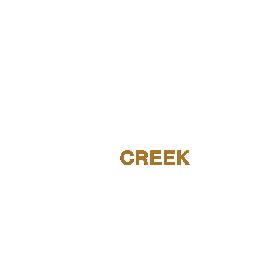
What is the most used tool on your farm? How old is it?
This is not really considered a tool but to me it’s learning knowledge and experience from my dad, Keith Fawcett.”
The most important lesson you’ve learned in this business?
Taking care of your customers.”
What about the beef cattle industry excites you the most?

The next generation, both cattle and people.”
Your favorite non-farm activity to do in your free time?
Coaching baseball.”
Which animal (any species) has left the greatest impact on you?
I don’t really have one that I can pick, but a few that come to the top of my head are, ECR RO Cash Flow 0245 ET, ECR Who Maker 210 ET, NJW 79Z Z311 Endure 173D ET, ECR Candi 5451 ET, RKK Izzy 161J (AKA, Mindy), and my daughter’s FECR bred and raised PB Hereford steer, Otis.”
UPCOMING SALES: Fall Female Sale, October 7, 2023

Hosted through SmartAuctions
Annual Production Sale, February 12, 2024

What is your least favorite job on the farm?
Running the feed wagon.”
Arguably the heaviest muscled bull in the 2023 Schaff’s Angus Valley sale offering. His dam is a phenotypic standout, and his 13 year old grandam is the #1 CED and #4 Milk EPD cow at Schaff’s Angus Valley.
Both bulls will be available on a first come first serve basis $30/straw and $40/cert. WIL MAYES 304-619-9327 | DALLAS WOLTEMATH 308-390-6400 | ZWTRANCH.COM
This full brother to S A V Downpour 8794 has unlimited potential. His Pathfinder dam combined stellar phenotype with a production WW record of 7/104.
 REG# 20478145
REG# 20480732
REG# 20478145
REG# 20480732
Incredible combination of balance and power in a calving ease package. Big Jon has impressed those who have seen him with a powerful phenotype to go with his top 1 % CED. His first 32 calves have been born unassisted.
Marvel is the standard for consistent phenotype here at ZWT. He also transmits a very userfriendly disposition to his offspring to go along with a top 1 % REA. The first daughters of Marvel have calved and show excellent udder quality.
 REG# 19738682
REG# 19091613
REG# 19738682
REG# 19091613
